Workplace Discrimination and its Impact on Employee Morale
VerifiedAdded on 2023/01/11
|31
|5969
|54
AI Summary
This research aims to analyze the impact of workplace discrimination on employee morale. It explores the concept of workplace discrimination, its negative impact on morale, and strategies to reduce discrimination in organizations. The study includes a case study on Marks & Spencer.
Contribute Materials
Your contribution can guide someone’s learning journey. Share your
documents today.
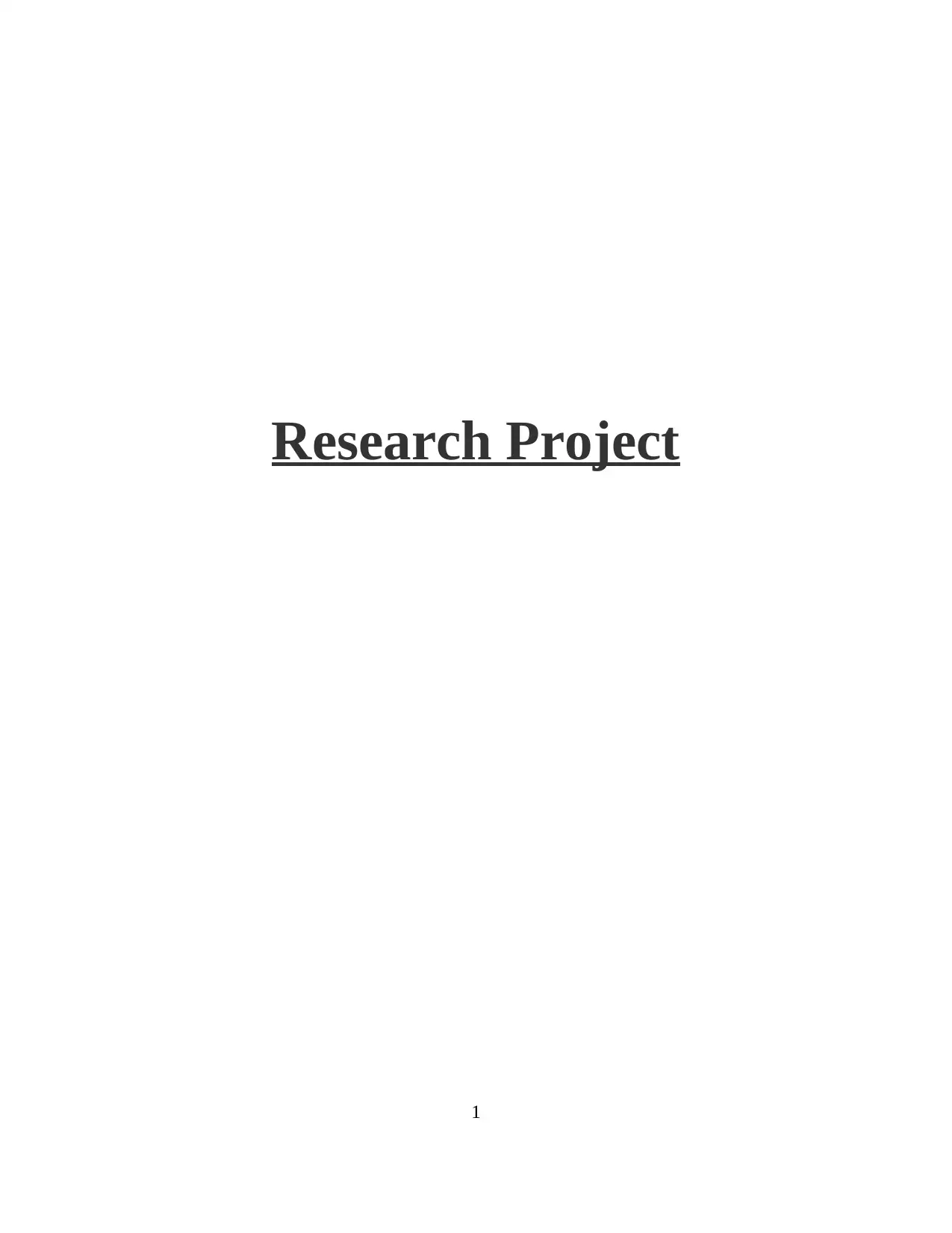
Research Project
1
1
Secure Best Marks with AI Grader
Need help grading? Try our AI Grader for instant feedback on your assignments.
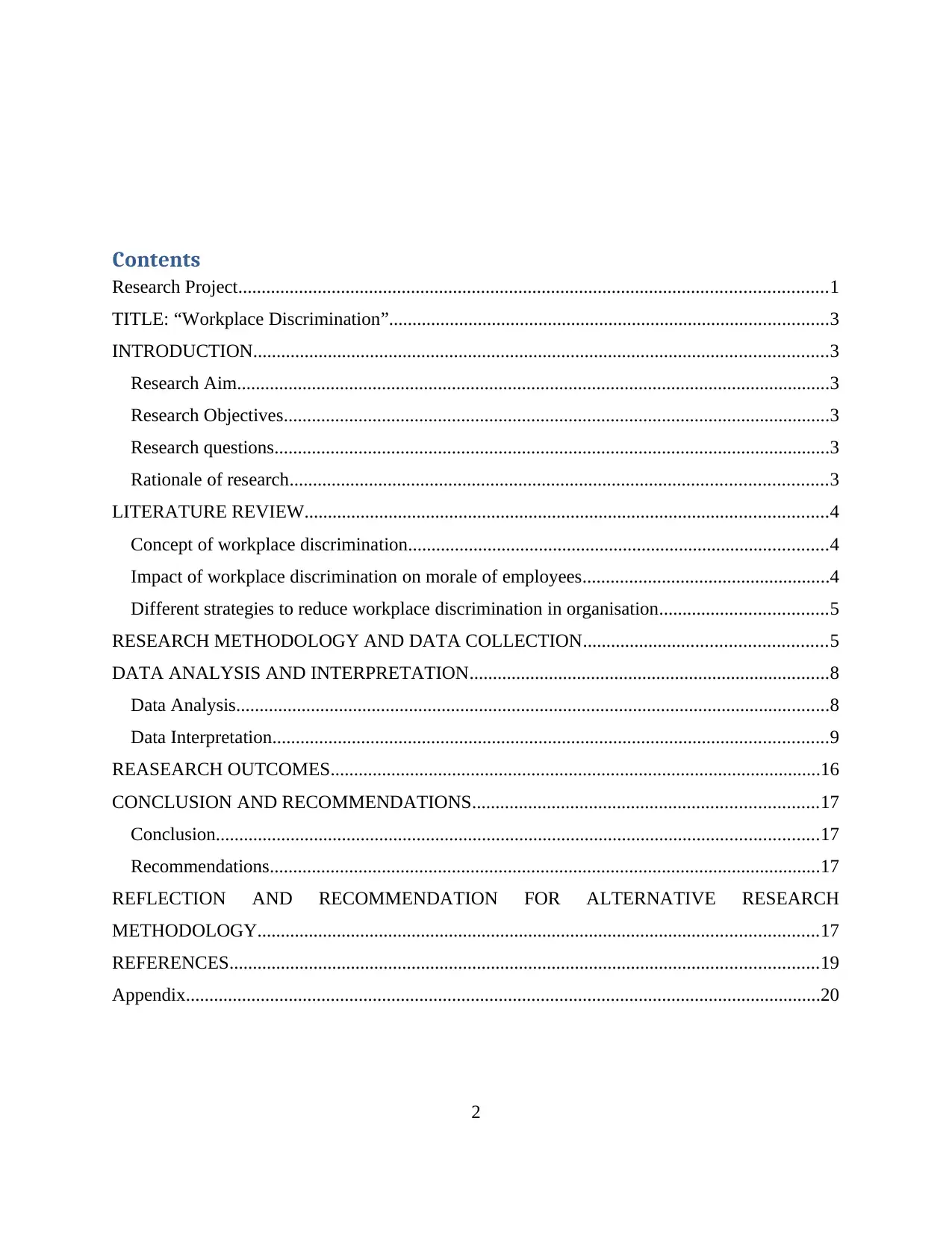
Contents
Research Project..............................................................................................................................1
TITLE: “Workplace Discrimination”..............................................................................................3
INTRODUCTION...........................................................................................................................3
Research Aim...............................................................................................................................3
Research Objectives.....................................................................................................................3
Research questions.......................................................................................................................3
Rationale of research...................................................................................................................3
LITERATURE REVIEW................................................................................................................4
Concept of workplace discrimination..........................................................................................4
Impact of workplace discrimination on morale of employees.....................................................4
Different strategies to reduce workplace discrimination in organisation....................................5
RESEARCH METHODOLOGY AND DATA COLLECTION....................................................5
DATA ANALYSIS AND INTERPRETATION.............................................................................8
Data Analysis...............................................................................................................................8
Data Interpretation.......................................................................................................................9
REASEARCH OUTCOMES.........................................................................................................16
CONCLUSION AND RECOMMENDATIONS..........................................................................17
Conclusion.................................................................................................................................17
Recommendations......................................................................................................................17
REFLECTION AND RECOMMENDATION FOR ALTERNATIVE RESEARCH
METHODOLOGY........................................................................................................................17
REFERENCES..............................................................................................................................19
Appendix........................................................................................................................................20
2
Research Project..............................................................................................................................1
TITLE: “Workplace Discrimination”..............................................................................................3
INTRODUCTION...........................................................................................................................3
Research Aim...............................................................................................................................3
Research Objectives.....................................................................................................................3
Research questions.......................................................................................................................3
Rationale of research...................................................................................................................3
LITERATURE REVIEW................................................................................................................4
Concept of workplace discrimination..........................................................................................4
Impact of workplace discrimination on morale of employees.....................................................4
Different strategies to reduce workplace discrimination in organisation....................................5
RESEARCH METHODOLOGY AND DATA COLLECTION....................................................5
DATA ANALYSIS AND INTERPRETATION.............................................................................8
Data Analysis...............................................................................................................................8
Data Interpretation.......................................................................................................................9
REASEARCH OUTCOMES.........................................................................................................16
CONCLUSION AND RECOMMENDATIONS..........................................................................17
Conclusion.................................................................................................................................17
Recommendations......................................................................................................................17
REFLECTION AND RECOMMENDATION FOR ALTERNATIVE RESEARCH
METHODOLOGY........................................................................................................................17
REFERENCES..............................................................................................................................19
Appendix........................................................................................................................................20
2
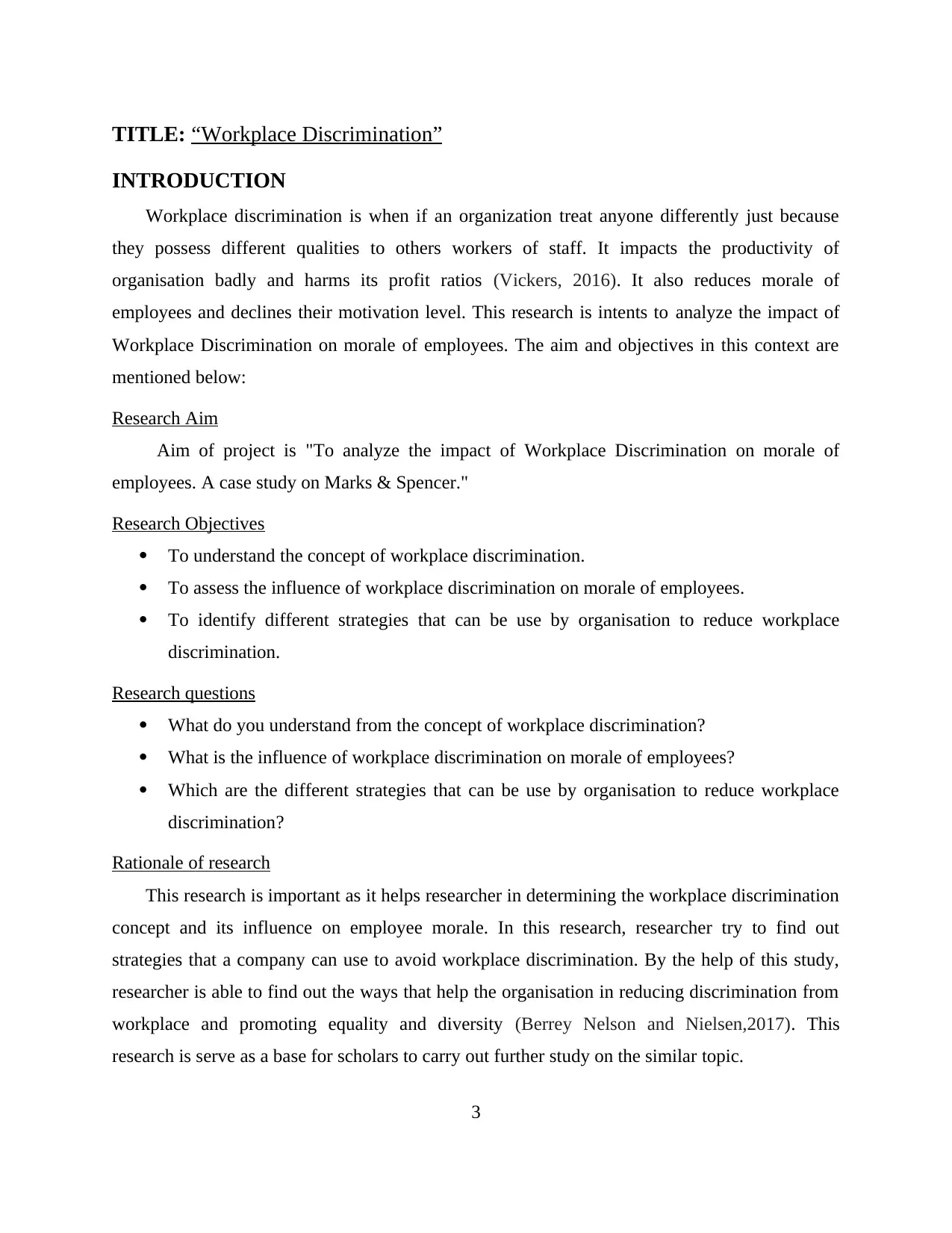
TITLE: “Workplace Discrimination”
INTRODUCTION
Workplace discrimination is when if an organization treat anyone differently just because
they possess different qualities to others workers of staff. It impacts the productivity of
organisation badly and harms its profit ratios (Vickers, 2016). It also reduces morale of
employees and declines their motivation level. This research is intents to analyze the impact of
Workplace Discrimination on morale of employees. The aim and objectives in this context are
mentioned below:
Research Aim
Aim of project is "To analyze the impact of Workplace Discrimination on morale of
employees. A case study on Marks & Spencer."
Research Objectives
To understand the concept of workplace discrimination.
To assess the influence of workplace discrimination on morale of employees.
To identify different strategies that can be use by organisation to reduce workplace
discrimination.
Research questions
What do you understand from the concept of workplace discrimination?
What is the influence of workplace discrimination on morale of employees?
Which are the different strategies that can be use by organisation to reduce workplace
discrimination?
Rationale of research
This research is important as it helps researcher in determining the workplace discrimination
concept and its influence on employee morale. In this research, researcher try to find out
strategies that a company can use to avoid workplace discrimination. By the help of this study,
researcher is able to find out the ways that help the organisation in reducing discrimination from
workplace and promoting equality and diversity (Berrey Nelson and Nielsen,2017). This
research is serve as a base for scholars to carry out further study on the similar topic.
3
INTRODUCTION
Workplace discrimination is when if an organization treat anyone differently just because
they possess different qualities to others workers of staff. It impacts the productivity of
organisation badly and harms its profit ratios (Vickers, 2016). It also reduces morale of
employees and declines their motivation level. This research is intents to analyze the impact of
Workplace Discrimination on morale of employees. The aim and objectives in this context are
mentioned below:
Research Aim
Aim of project is "To analyze the impact of Workplace Discrimination on morale of
employees. A case study on Marks & Spencer."
Research Objectives
To understand the concept of workplace discrimination.
To assess the influence of workplace discrimination on morale of employees.
To identify different strategies that can be use by organisation to reduce workplace
discrimination.
Research questions
What do you understand from the concept of workplace discrimination?
What is the influence of workplace discrimination on morale of employees?
Which are the different strategies that can be use by organisation to reduce workplace
discrimination?
Rationale of research
This research is important as it helps researcher in determining the workplace discrimination
concept and its influence on employee morale. In this research, researcher try to find out
strategies that a company can use to avoid workplace discrimination. By the help of this study,
researcher is able to find out the ways that help the organisation in reducing discrimination from
workplace and promoting equality and diversity (Berrey Nelson and Nielsen,2017). This
research is serve as a base for scholars to carry out further study on the similar topic.
3

LITERATURE REVIEW
Concept of workplace discrimination
As per the view point of Ali, Yamada and Mahmood, (2015), Discrimination in the organisation
is when a worker is treated unfavorably cause of sexuality, religion, race, pregnancy and
maternity, gender or disability. Direct discrimination is when one is treated less than the other
employees. For instance, one has the qualifications and capabilities to do that particular job but
organizations turn them out cause of gender. Direct discrimination also starts when organizations
pay someone less they actually deserve or than other employees. Organization many times
unfairly reject the request for no good reason. Indirect discrimination happens when some rules
or regulations selects disadvantages of certain staff members. Organisation discrimination also
affect firing, hiring, salary, promotions, training, job assignment, layoffs or benefits. Harassment,
is also a great setback of organisation discrimination. Individuals have to face harassment for no
reason. Harassment could make any individual feel humiliated or offended (O'Loughlin and et.
al., 2017).
Impact of workplace discrimination on morale of employees
According to the view of Chavez and et. al., (2015), Discrimination today is present in
almost every organisation. It simply means biased treatment among individuals. Person being
discriminated is not given same opportunities as others. Eventually, discrimination in
organization affect individuals deeply. Many individuals are excluding from their privileges
which led their morale down. Discrimination can cause serious health issues mentally or
physically, like headache, stress level increases, anxiety and many more. Stress or anxiety break
down their bodies or can trigger psychological reactivity. Discrimination can also have a
negative impact on company's status and on its finances. The working atmosphere is also
negative, and unfavorably for the employees. Due to this Discrimination in organizations many
individuals who are capable for the job, don't get the job. Individuals who connect with the same
qualities as the victim might also feel like discriminated. They feel higher levels of hostility,
suspicion, stress, mistrust, rivalry, depression and resentment (Triana Jayasinghe and Pieper,
2015). Negative emotions or vibes can be contagious; the vibes get ruin in the organisation
which ultimately led to negative results. All these bad feelings lead to reduced morale of the
employees, reduced communication, teamwork, focus and productivity. There may also
4
Concept of workplace discrimination
As per the view point of Ali, Yamada and Mahmood, (2015), Discrimination in the organisation
is when a worker is treated unfavorably cause of sexuality, religion, race, pregnancy and
maternity, gender or disability. Direct discrimination is when one is treated less than the other
employees. For instance, one has the qualifications and capabilities to do that particular job but
organizations turn them out cause of gender. Direct discrimination also starts when organizations
pay someone less they actually deserve or than other employees. Organization many times
unfairly reject the request for no good reason. Indirect discrimination happens when some rules
or regulations selects disadvantages of certain staff members. Organisation discrimination also
affect firing, hiring, salary, promotions, training, job assignment, layoffs or benefits. Harassment,
is also a great setback of organisation discrimination. Individuals have to face harassment for no
reason. Harassment could make any individual feel humiliated or offended (O'Loughlin and et.
al., 2017).
Impact of workplace discrimination on morale of employees
According to the view of Chavez and et. al., (2015), Discrimination today is present in
almost every organisation. It simply means biased treatment among individuals. Person being
discriminated is not given same opportunities as others. Eventually, discrimination in
organization affect individuals deeply. Many individuals are excluding from their privileges
which led their morale down. Discrimination can cause serious health issues mentally or
physically, like headache, stress level increases, anxiety and many more. Stress or anxiety break
down their bodies or can trigger psychological reactivity. Discrimination can also have a
negative impact on company's status and on its finances. The working atmosphere is also
negative, and unfavorably for the employees. Due to this Discrimination in organizations many
individuals who are capable for the job, don't get the job. Individuals who connect with the same
qualities as the victim might also feel like discriminated. They feel higher levels of hostility,
suspicion, stress, mistrust, rivalry, depression and resentment (Triana Jayasinghe and Pieper,
2015). Negative emotions or vibes can be contagious; the vibes get ruin in the organisation
which ultimately led to negative results. All these bad feelings lead to reduced morale of the
employees, reduced communication, teamwork, focus and productivity. There may also
4
Secure Best Marks with AI Grader
Need help grading? Try our AI Grader for instant feedback on your assignments.
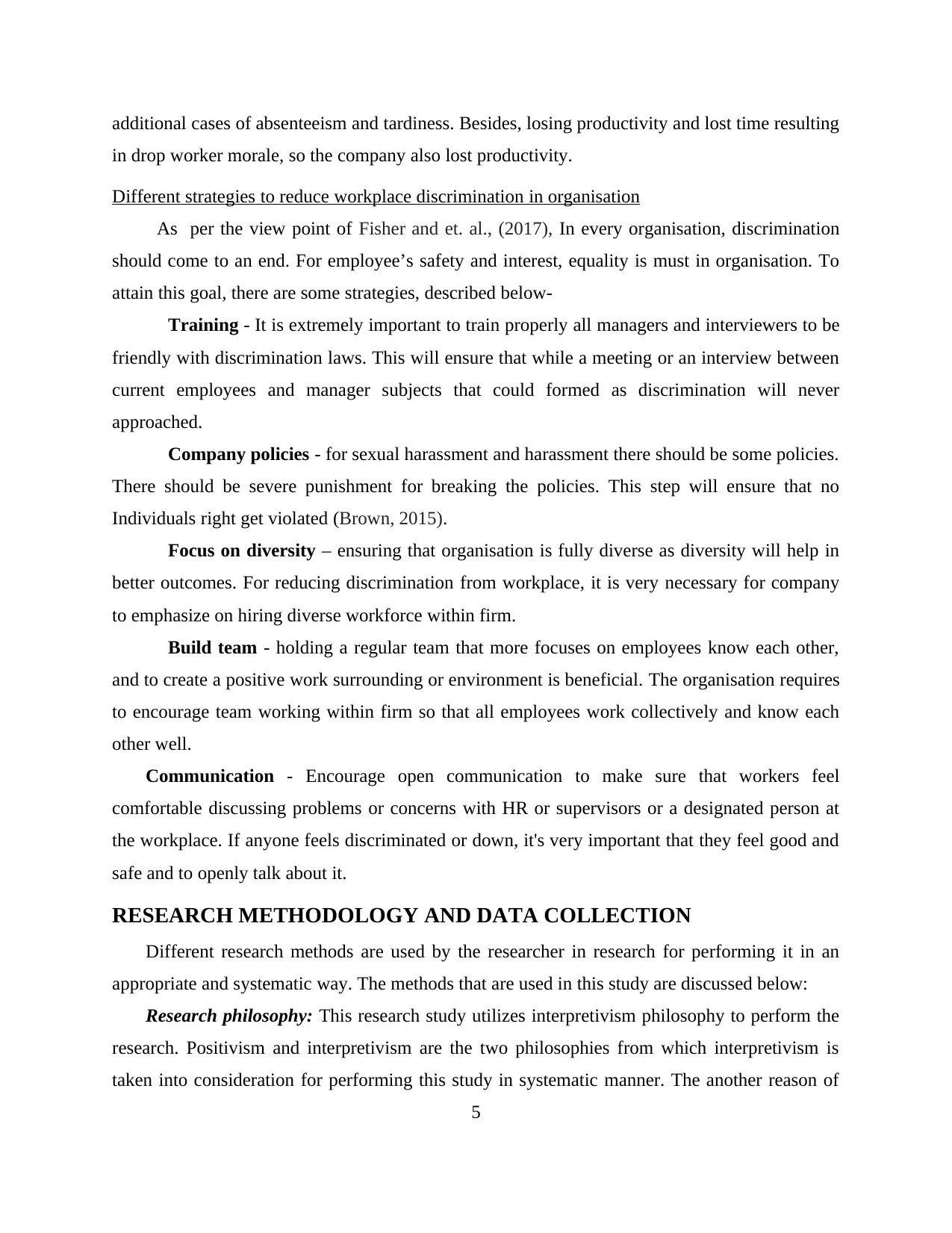
additional cases of absenteeism and tardiness. Besides, losing productivity and lost time resulting
in drop worker morale, so the company also lost productivity.
Different strategies to reduce workplace discrimination in organisation
As per the view point of Fisher and et. al., (2017), In every organisation, discrimination
should come to an end. For employee’s safety and interest, equality is must in organisation. To
attain this goal, there are some strategies, described below-
Training - It is extremely important to train properly all managers and interviewers to be
friendly with discrimination laws. This will ensure that while a meeting or an interview between
current employees and manager subjects that could formed as discrimination will never
approached.
Company policies - for sexual harassment and harassment there should be some policies.
There should be severe punishment for breaking the policies. This step will ensure that no
Individuals right get violated (Brown, 2015).
Focus on diversity – ensuring that organisation is fully diverse as diversity will help in
better outcomes. For reducing discrimination from workplace, it is very necessary for company
to emphasize on hiring diverse workforce within firm.
Build team - holding a regular team that more focuses on employees know each other,
and to create a positive work surrounding or environment is beneficial. The organisation requires
to encourage team working within firm so that all employees work collectively and know each
other well.
Communication - Encourage open communication to make sure that workers feel
comfortable discussing problems or concerns with HR or supervisors or a designated person at
the workplace. If anyone feels discriminated or down, it's very important that they feel good and
safe and to openly talk about it.
RESEARCH METHODOLOGY AND DATA COLLECTION
Different research methods are used by the researcher in research for performing it in an
appropriate and systematic way. The methods that are used in this study are discussed below:
Research philosophy: This research study utilizes interpretivism philosophy to perform the
research. Positivism and interpretivism are the two philosophies from which interpretivism is
taken into consideration for performing this study in systematic manner. The another reason of
5
in drop worker morale, so the company also lost productivity.
Different strategies to reduce workplace discrimination in organisation
As per the view point of Fisher and et. al., (2017), In every organisation, discrimination
should come to an end. For employee’s safety and interest, equality is must in organisation. To
attain this goal, there are some strategies, described below-
Training - It is extremely important to train properly all managers and interviewers to be
friendly with discrimination laws. This will ensure that while a meeting or an interview between
current employees and manager subjects that could formed as discrimination will never
approached.
Company policies - for sexual harassment and harassment there should be some policies.
There should be severe punishment for breaking the policies. This step will ensure that no
Individuals right get violated (Brown, 2015).
Focus on diversity – ensuring that organisation is fully diverse as diversity will help in
better outcomes. For reducing discrimination from workplace, it is very necessary for company
to emphasize on hiring diverse workforce within firm.
Build team - holding a regular team that more focuses on employees know each other,
and to create a positive work surrounding or environment is beneficial. The organisation requires
to encourage team working within firm so that all employees work collectively and know each
other well.
Communication - Encourage open communication to make sure that workers feel
comfortable discussing problems or concerns with HR or supervisors or a designated person at
the workplace. If anyone feels discriminated or down, it's very important that they feel good and
safe and to openly talk about it.
RESEARCH METHODOLOGY AND DATA COLLECTION
Different research methods are used by the researcher in research for performing it in an
appropriate and systematic way. The methods that are used in this study are discussed below:
Research philosophy: This research study utilizes interpretivism philosophy to perform the
research. Positivism and interpretivism are the two philosophies from which interpretivism is
taken into consideration for performing this study in systematic manner. The another reason of
5
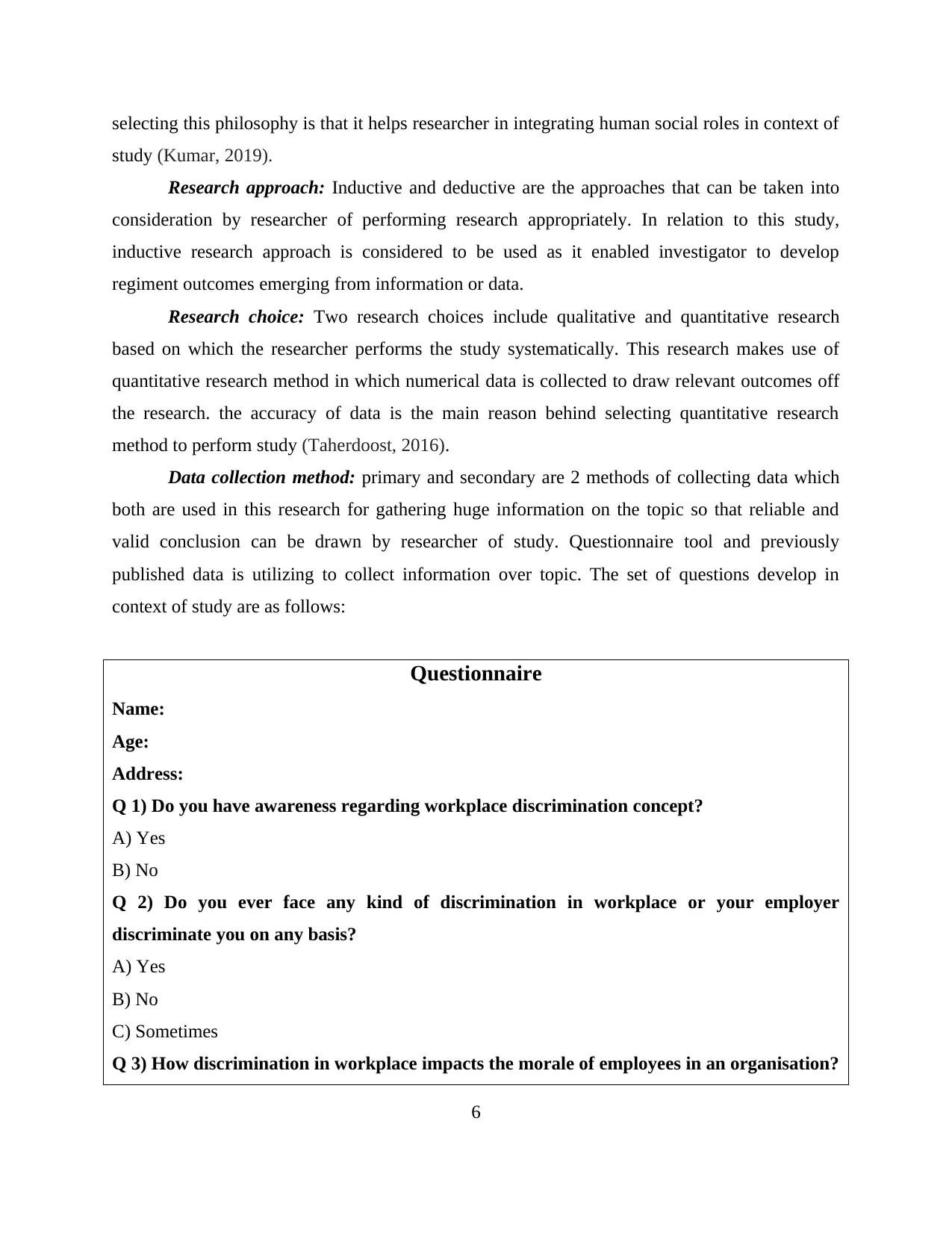
selecting this philosophy is that it helps researcher in integrating human social roles in context of
study (Kumar, 2019).
Research approach: Inductive and deductive are the approaches that can be taken into
consideration by researcher of performing research appropriately. In relation to this study,
inductive research approach is considered to be used as it enabled investigator to develop
regiment outcomes emerging from information or data.
Research choice: Two research choices include qualitative and quantitative research
based on which the researcher performs the study systematically. This research makes use of
quantitative research method in which numerical data is collected to draw relevant outcomes off
the research. the accuracy of data is the main reason behind selecting quantitative research
method to perform study (Taherdoost, 2016).
Data collection method: primary and secondary are 2 methods of collecting data which
both are used in this research for gathering huge information on the topic so that reliable and
valid conclusion can be drawn by researcher of study. Questionnaire tool and previously
published data is utilizing to collect information over topic. The set of questions develop in
context of study are as follows:
Questionnaire
Name:
Age:
Address:
Q 1) Do you have awareness regarding workplace discrimination concept?
A) Yes
B) No
Q 2) Do you ever face any kind of discrimination in workplace or your employer
discriminate you on any basis?
A) Yes
B) No
C) Sometimes
Q 3) How discrimination in workplace impacts the morale of employees in an organisation?
6
study (Kumar, 2019).
Research approach: Inductive and deductive are the approaches that can be taken into
consideration by researcher of performing research appropriately. In relation to this study,
inductive research approach is considered to be used as it enabled investigator to develop
regiment outcomes emerging from information or data.
Research choice: Two research choices include qualitative and quantitative research
based on which the researcher performs the study systematically. This research makes use of
quantitative research method in which numerical data is collected to draw relevant outcomes off
the research. the accuracy of data is the main reason behind selecting quantitative research
method to perform study (Taherdoost, 2016).
Data collection method: primary and secondary are 2 methods of collecting data which
both are used in this research for gathering huge information on the topic so that reliable and
valid conclusion can be drawn by researcher of study. Questionnaire tool and previously
published data is utilizing to collect information over topic. The set of questions develop in
context of study are as follows:
Questionnaire
Name:
Age:
Address:
Q 1) Do you have awareness regarding workplace discrimination concept?
A) Yes
B) No
Q 2) Do you ever face any kind of discrimination in workplace or your employer
discriminate you on any basis?
A) Yes
B) No
C) Sometimes
Q 3) How discrimination in workplace impacts the morale of employees in an organisation?
6
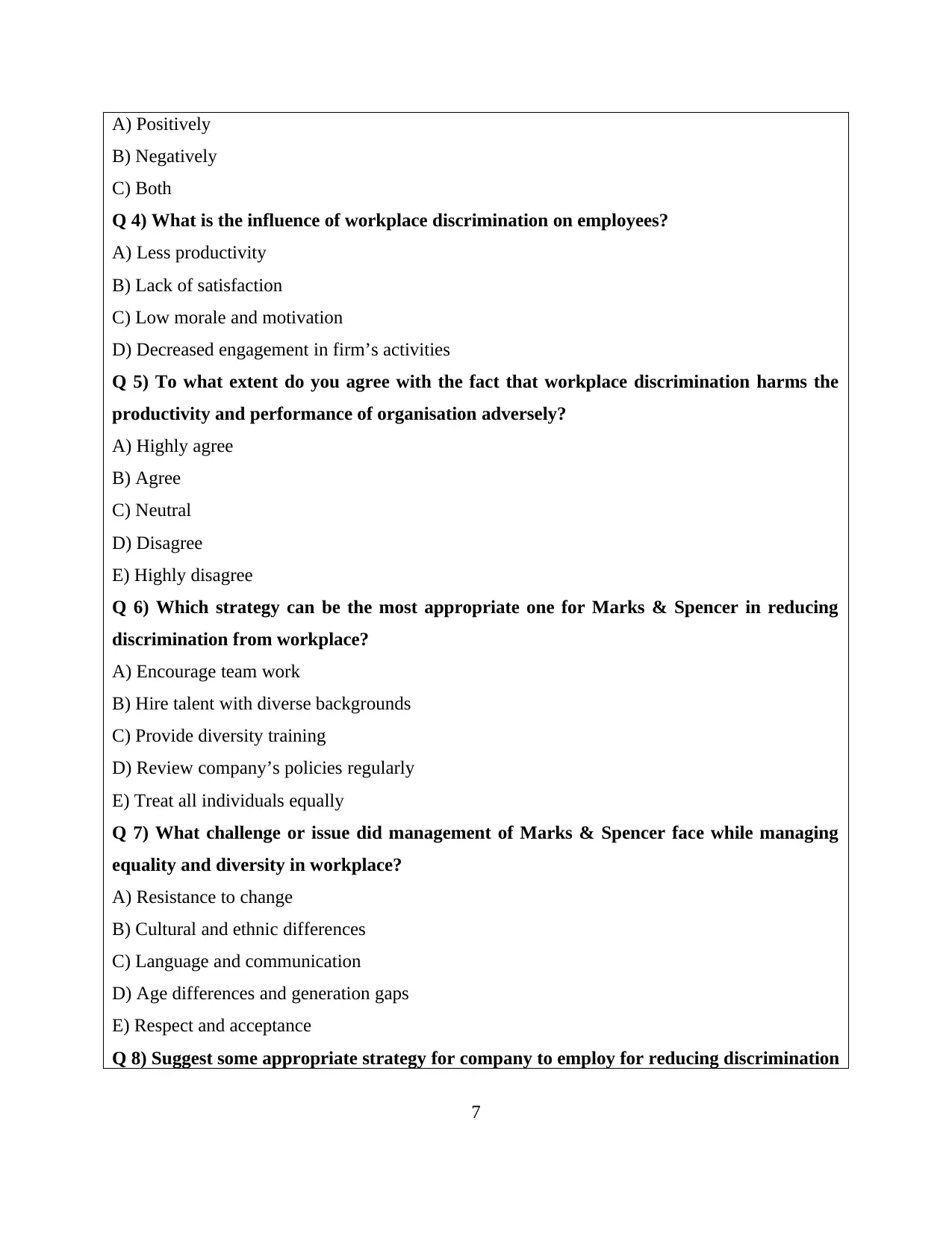
A) Positively
B) Negatively
C) Both
Q 4) What is the influence of workplace discrimination on employees?
A) Less productivity
B) Lack of satisfaction
C) Low morale and motivation
D) Decreased engagement in firm’s activities
Q 5) To what extent do you agree with the fact that workplace discrimination harms the
productivity and performance of organisation adversely?
A) Highly agree
B) Agree
C) Neutral
D) Disagree
E) Highly disagree
Q 6) Which strategy can be the most appropriate one for Marks & Spencer in reducing
discrimination from workplace?
A) Encourage team work
B) Hire talent with diverse backgrounds
C) Provide diversity training
D) Review company’s policies regularly
E) Treat all individuals equally
Q 7) What challenge or issue did management of Marks & Spencer face while managing
equality and diversity in workplace?
A) Resistance to change
B) Cultural and ethnic differences
C) Language and communication
D) Age differences and generation gaps
E) Respect and acceptance
Q 8) Suggest some appropriate strategy for company to employ for reducing discrimination
7
B) Negatively
C) Both
Q 4) What is the influence of workplace discrimination on employees?
A) Less productivity
B) Lack of satisfaction
C) Low morale and motivation
D) Decreased engagement in firm’s activities
Q 5) To what extent do you agree with the fact that workplace discrimination harms the
productivity and performance of organisation adversely?
A) Highly agree
B) Agree
C) Neutral
D) Disagree
E) Highly disagree
Q 6) Which strategy can be the most appropriate one for Marks & Spencer in reducing
discrimination from workplace?
A) Encourage team work
B) Hire talent with diverse backgrounds
C) Provide diversity training
D) Review company’s policies regularly
E) Treat all individuals equally
Q 7) What challenge or issue did management of Marks & Spencer face while managing
equality and diversity in workplace?
A) Resistance to change
B) Cultural and ethnic differences
C) Language and communication
D) Age differences and generation gaps
E) Respect and acceptance
Q 8) Suggest some appropriate strategy for company to employ for reducing discrimination
7
Paraphrase This Document
Need a fresh take? Get an instant paraphrase of this document with our AI Paraphraser
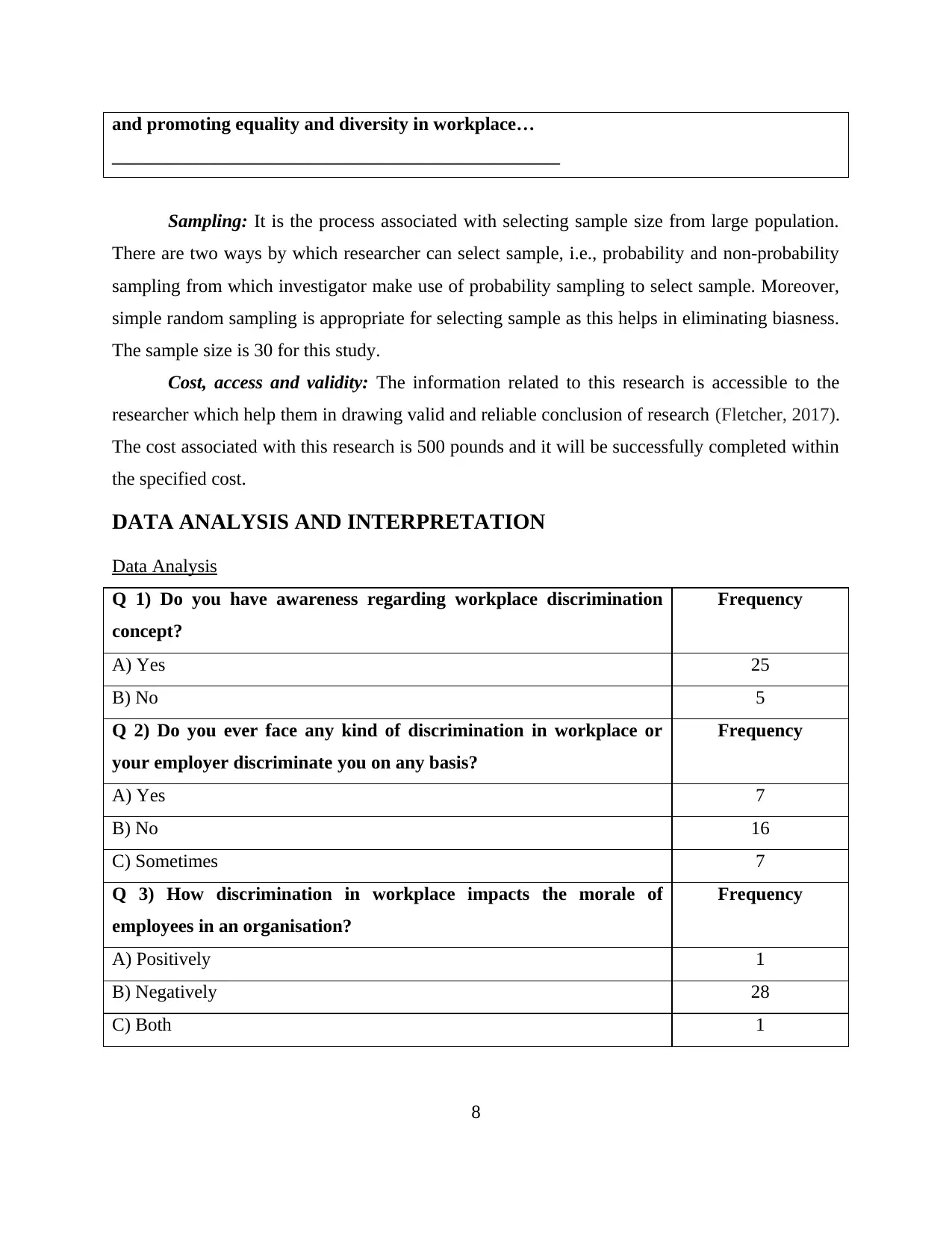
and promoting equality and diversity in workplace…
________________________________________________
Sampling: It is the process associated with selecting sample size from large population.
There are two ways by which researcher can select sample, i.e., probability and non-probability
sampling from which investigator make use of probability sampling to select sample. Moreover,
simple random sampling is appropriate for selecting sample as this helps in eliminating biasness.
The sample size is 30 for this study.
Cost, access and validity: The information related to this research is accessible to the
researcher which help them in drawing valid and reliable conclusion of research (Fletcher, 2017).
The cost associated with this research is 500 pounds and it will be successfully completed within
the specified cost.
DATA ANALYSIS AND INTERPRETATION
Data Analysis
Q 1) Do you have awareness regarding workplace discrimination
concept?
Frequency
A) Yes 25
B) No 5
Q 2) Do you ever face any kind of discrimination in workplace or
your employer discriminate you on any basis?
Frequency
A) Yes 7
B) No 16
C) Sometimes 7
Q 3) How discrimination in workplace impacts the morale of
employees in an organisation?
Frequency
A) Positively 1
B) Negatively 28
C) Both 1
8
________________________________________________
Sampling: It is the process associated with selecting sample size from large population.
There are two ways by which researcher can select sample, i.e., probability and non-probability
sampling from which investigator make use of probability sampling to select sample. Moreover,
simple random sampling is appropriate for selecting sample as this helps in eliminating biasness.
The sample size is 30 for this study.
Cost, access and validity: The information related to this research is accessible to the
researcher which help them in drawing valid and reliable conclusion of research (Fletcher, 2017).
The cost associated with this research is 500 pounds and it will be successfully completed within
the specified cost.
DATA ANALYSIS AND INTERPRETATION
Data Analysis
Q 1) Do you have awareness regarding workplace discrimination
concept?
Frequency
A) Yes 25
B) No 5
Q 2) Do you ever face any kind of discrimination in workplace or
your employer discriminate you on any basis?
Frequency
A) Yes 7
B) No 16
C) Sometimes 7
Q 3) How discrimination in workplace impacts the morale of
employees in an organisation?
Frequency
A) Positively 1
B) Negatively 28
C) Both 1
8
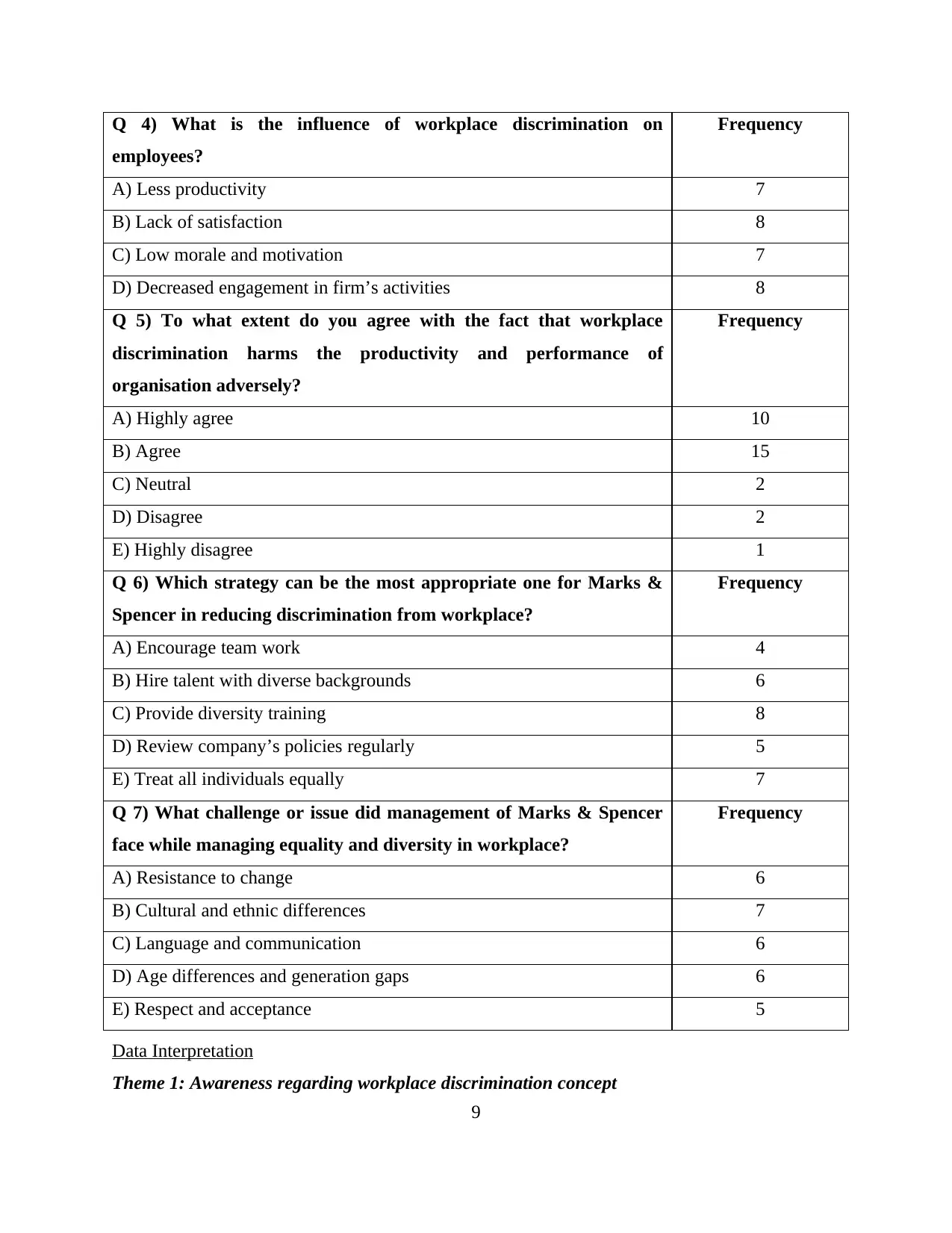
Q 4) What is the influence of workplace discrimination on
employees?
Frequency
A) Less productivity 7
B) Lack of satisfaction 8
C) Low morale and motivation 7
D) Decreased engagement in firm’s activities 8
Q 5) To what extent do you agree with the fact that workplace
discrimination harms the productivity and performance of
organisation adversely?
Frequency
A) Highly agree 10
B) Agree 15
C) Neutral 2
D) Disagree 2
E) Highly disagree 1
Q 6) Which strategy can be the most appropriate one for Marks &
Spencer in reducing discrimination from workplace?
Frequency
A) Encourage team work 4
B) Hire talent with diverse backgrounds 6
C) Provide diversity training 8
D) Review company’s policies regularly 5
E) Treat all individuals equally 7
Q 7) What challenge or issue did management of Marks & Spencer
face while managing equality and diversity in workplace?
Frequency
A) Resistance to change 6
B) Cultural and ethnic differences 7
C) Language and communication 6
D) Age differences and generation gaps 6
E) Respect and acceptance 5
Data Interpretation
Theme 1: Awareness regarding workplace discrimination concept
9
employees?
Frequency
A) Less productivity 7
B) Lack of satisfaction 8
C) Low morale and motivation 7
D) Decreased engagement in firm’s activities 8
Q 5) To what extent do you agree with the fact that workplace
discrimination harms the productivity and performance of
organisation adversely?
Frequency
A) Highly agree 10
B) Agree 15
C) Neutral 2
D) Disagree 2
E) Highly disagree 1
Q 6) Which strategy can be the most appropriate one for Marks &
Spencer in reducing discrimination from workplace?
Frequency
A) Encourage team work 4
B) Hire talent with diverse backgrounds 6
C) Provide diversity training 8
D) Review company’s policies regularly 5
E) Treat all individuals equally 7
Q 7) What challenge or issue did management of Marks & Spencer
face while managing equality and diversity in workplace?
Frequency
A) Resistance to change 6
B) Cultural and ethnic differences 7
C) Language and communication 6
D) Age differences and generation gaps 6
E) Respect and acceptance 5
Data Interpretation
Theme 1: Awareness regarding workplace discrimination concept
9
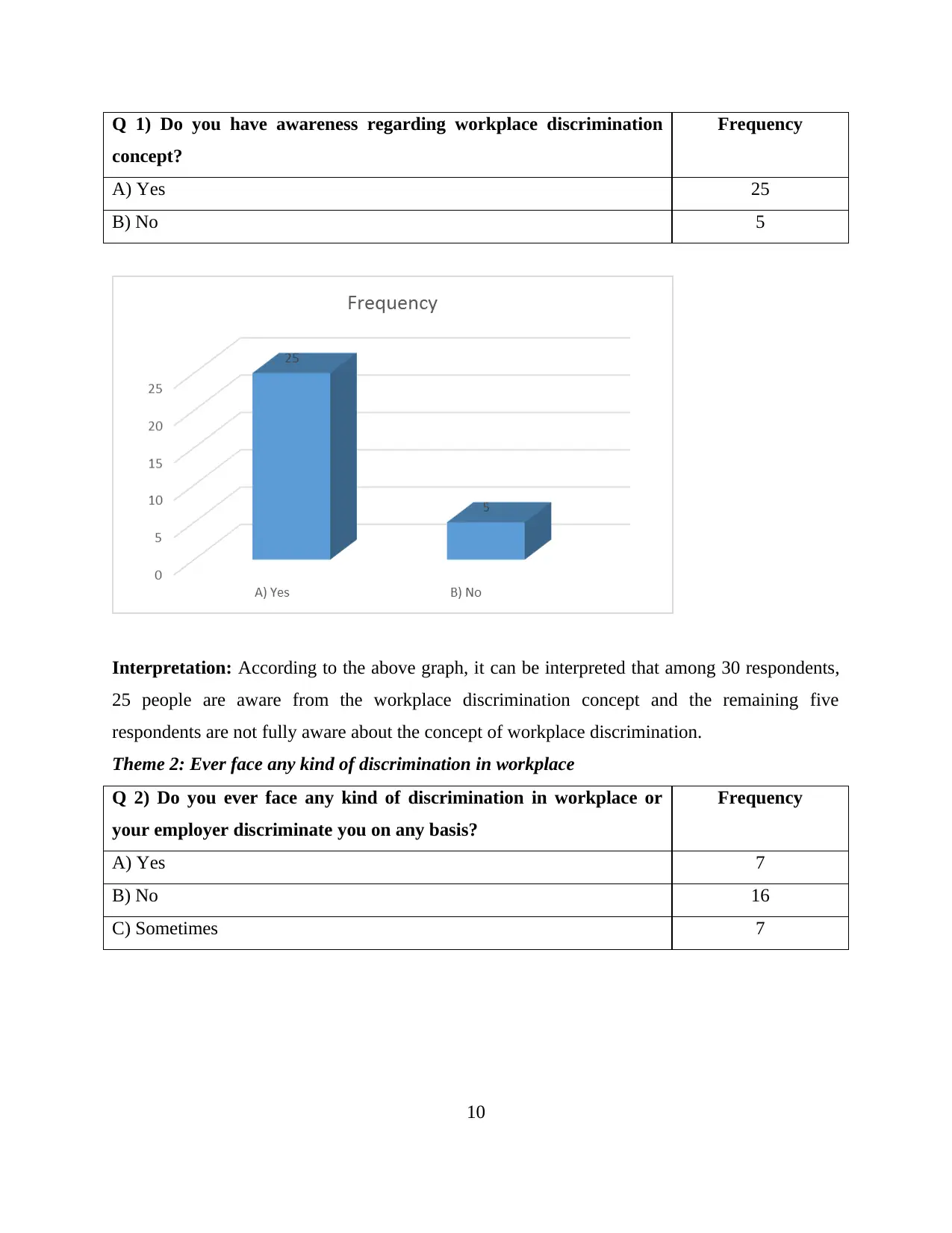
Q 1) Do you have awareness regarding workplace discrimination
concept?
Frequency
A) Yes 25
B) No 5
Interpretation: According to the above graph, it can be interpreted that among 30 respondents,
25 people are aware from the workplace discrimination concept and the remaining five
respondents are not fully aware about the concept of workplace discrimination.
Theme 2: Ever face any kind of discrimination in workplace
Q 2) Do you ever face any kind of discrimination in workplace or
your employer discriminate you on any basis?
Frequency
A) Yes 7
B) No 16
C) Sometimes 7
10
concept?
Frequency
A) Yes 25
B) No 5
Interpretation: According to the above graph, it can be interpreted that among 30 respondents,
25 people are aware from the workplace discrimination concept and the remaining five
respondents are not fully aware about the concept of workplace discrimination.
Theme 2: Ever face any kind of discrimination in workplace
Q 2) Do you ever face any kind of discrimination in workplace or
your employer discriminate you on any basis?
Frequency
A) Yes 7
B) No 16
C) Sometimes 7
10
Secure Best Marks with AI Grader
Need help grading? Try our AI Grader for instant feedback on your assignments.
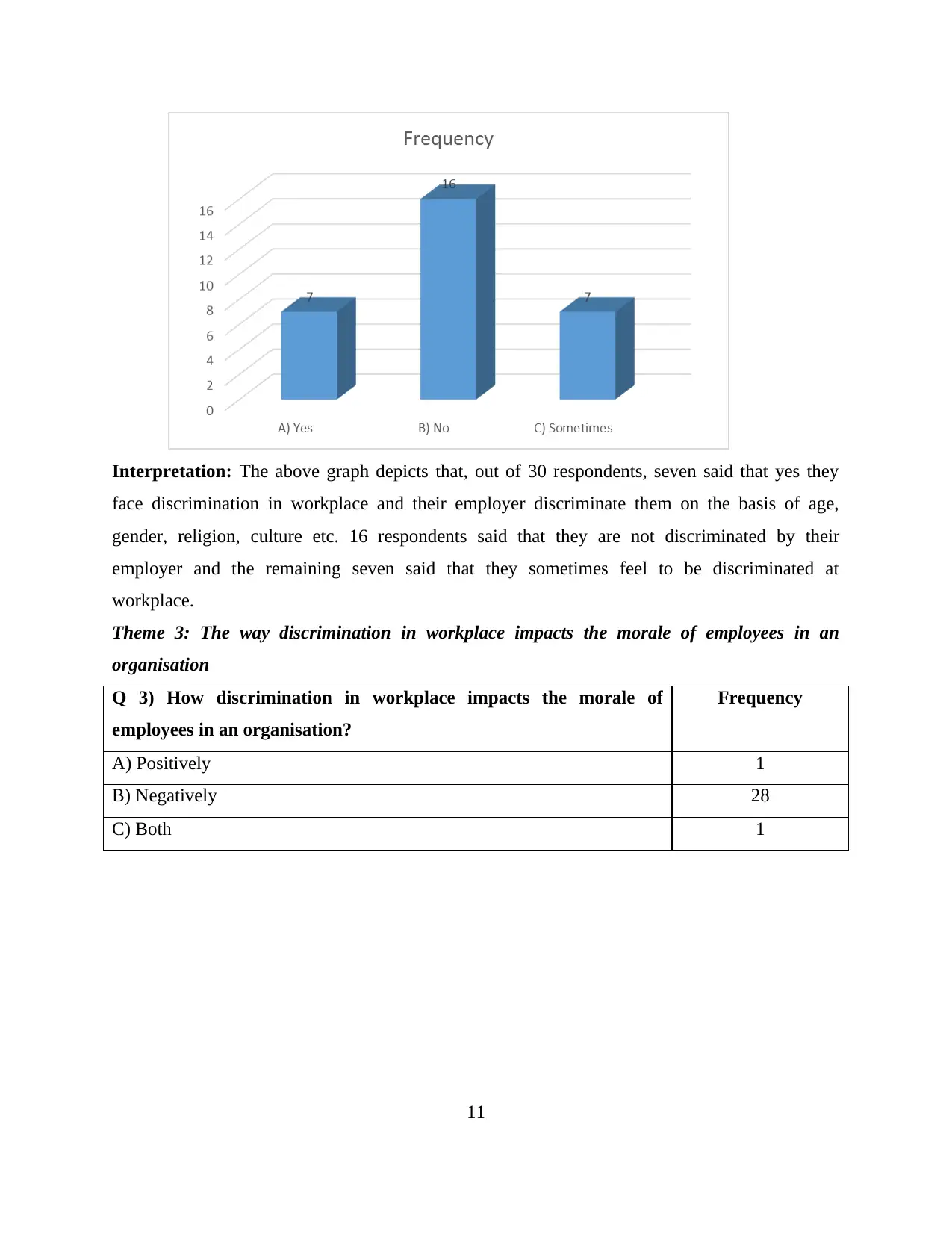
Interpretation: The above graph depicts that, out of 30 respondents, seven said that yes they
face discrimination in workplace and their employer discriminate them on the basis of age,
gender, religion, culture etc. 16 respondents said that they are not discriminated by their
employer and the remaining seven said that they sometimes feel to be discriminated at
workplace.
Theme 3: The way discrimination in workplace impacts the morale of employees in an
organisation
Q 3) How discrimination in workplace impacts the morale of
employees in an organisation?
Frequency
A) Positively 1
B) Negatively 28
C) Both 1
11
face discrimination in workplace and their employer discriminate them on the basis of age,
gender, religion, culture etc. 16 respondents said that they are not discriminated by their
employer and the remaining seven said that they sometimes feel to be discriminated at
workplace.
Theme 3: The way discrimination in workplace impacts the morale of employees in an
organisation
Q 3) How discrimination in workplace impacts the morale of
employees in an organisation?
Frequency
A) Positively 1
B) Negatively 28
C) Both 1
11
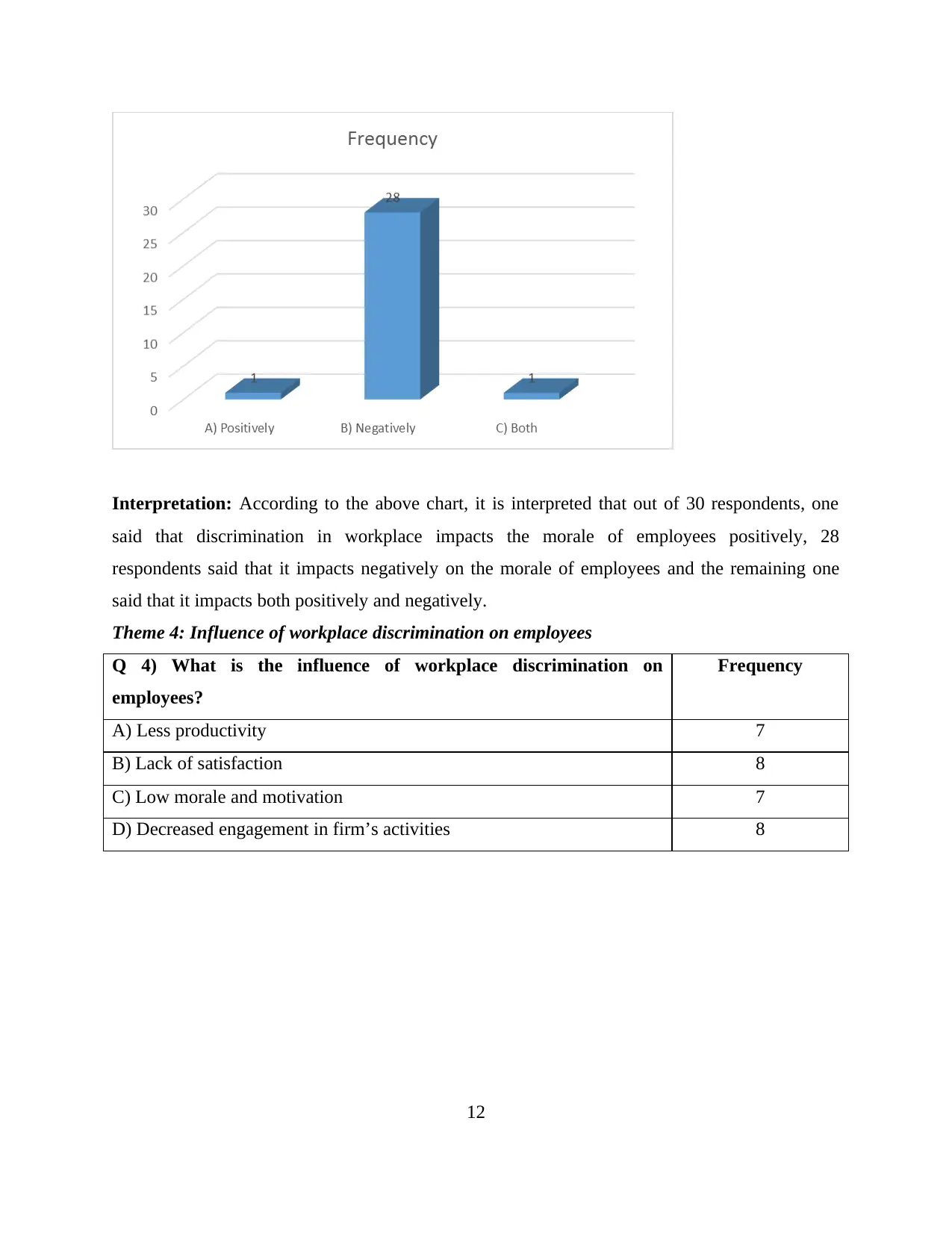
Interpretation: According to the above chart, it is interpreted that out of 30 respondents, one
said that discrimination in workplace impacts the morale of employees positively, 28
respondents said that it impacts negatively on the morale of employees and the remaining one
said that it impacts both positively and negatively.
Theme 4: Influence of workplace discrimination on employees
Q 4) What is the influence of workplace discrimination on
employees?
Frequency
A) Less productivity 7
B) Lack of satisfaction 8
C) Low morale and motivation 7
D) Decreased engagement in firm’s activities 8
12
said that discrimination in workplace impacts the morale of employees positively, 28
respondents said that it impacts negatively on the morale of employees and the remaining one
said that it impacts both positively and negatively.
Theme 4: Influence of workplace discrimination on employees
Q 4) What is the influence of workplace discrimination on
employees?
Frequency
A) Less productivity 7
B) Lack of satisfaction 8
C) Low morale and motivation 7
D) Decreased engagement in firm’s activities 8
12
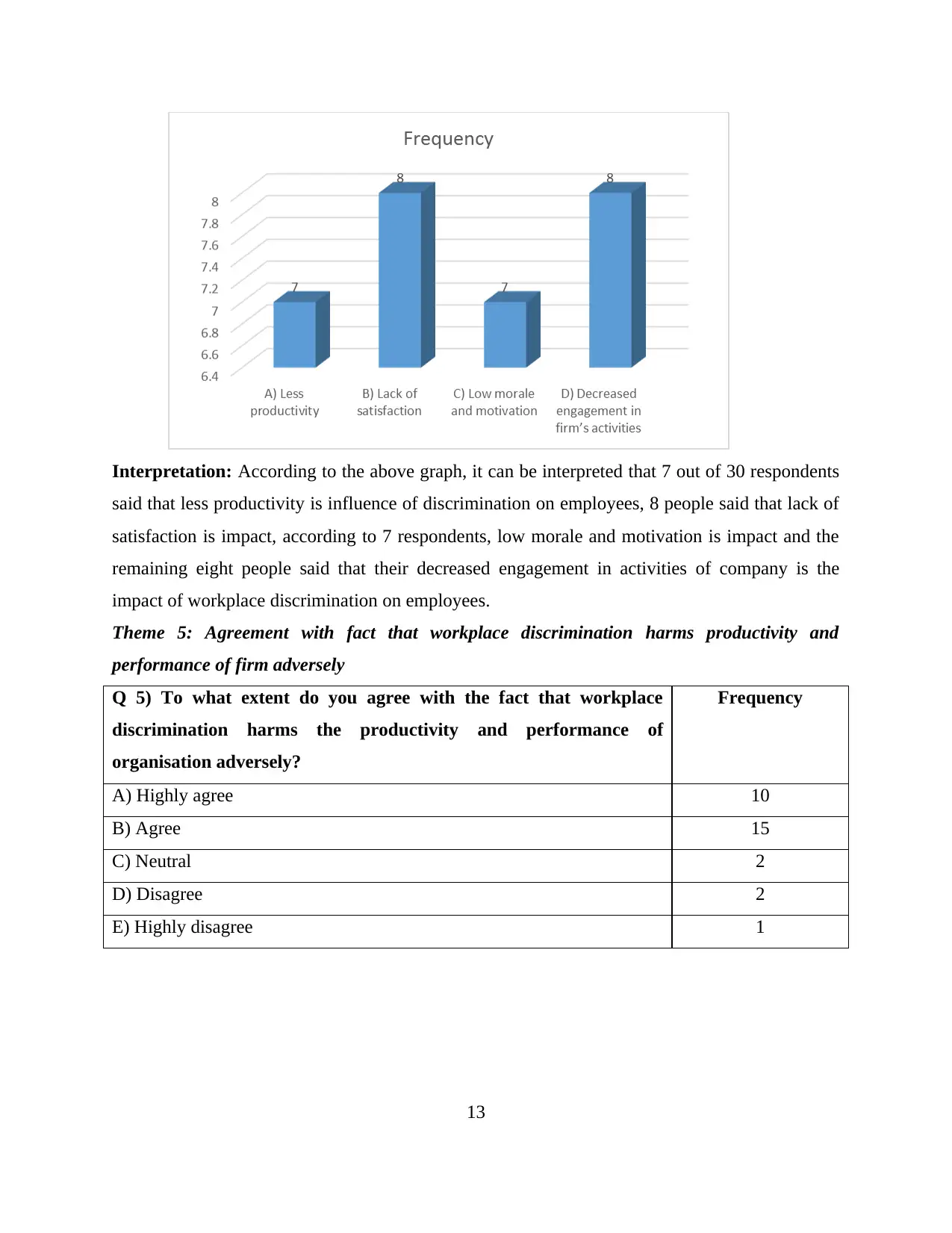
Interpretation: According to the above graph, it can be interpreted that 7 out of 30 respondents
said that less productivity is influence of discrimination on employees, 8 people said that lack of
satisfaction is impact, according to 7 respondents, low morale and motivation is impact and the
remaining eight people said that their decreased engagement in activities of company is the
impact of workplace discrimination on employees.
Theme 5: Agreement with fact that workplace discrimination harms productivity and
performance of firm adversely
Q 5) To what extent do you agree with the fact that workplace
discrimination harms the productivity and performance of
organisation adversely?
Frequency
A) Highly agree 10
B) Agree 15
C) Neutral 2
D) Disagree 2
E) Highly disagree 1
13
said that less productivity is influence of discrimination on employees, 8 people said that lack of
satisfaction is impact, according to 7 respondents, low morale and motivation is impact and the
remaining eight people said that their decreased engagement in activities of company is the
impact of workplace discrimination on employees.
Theme 5: Agreement with fact that workplace discrimination harms productivity and
performance of firm adversely
Q 5) To what extent do you agree with the fact that workplace
discrimination harms the productivity and performance of
organisation adversely?
Frequency
A) Highly agree 10
B) Agree 15
C) Neutral 2
D) Disagree 2
E) Highly disagree 1
13
Paraphrase This Document
Need a fresh take? Get an instant paraphrase of this document with our AI Paraphraser
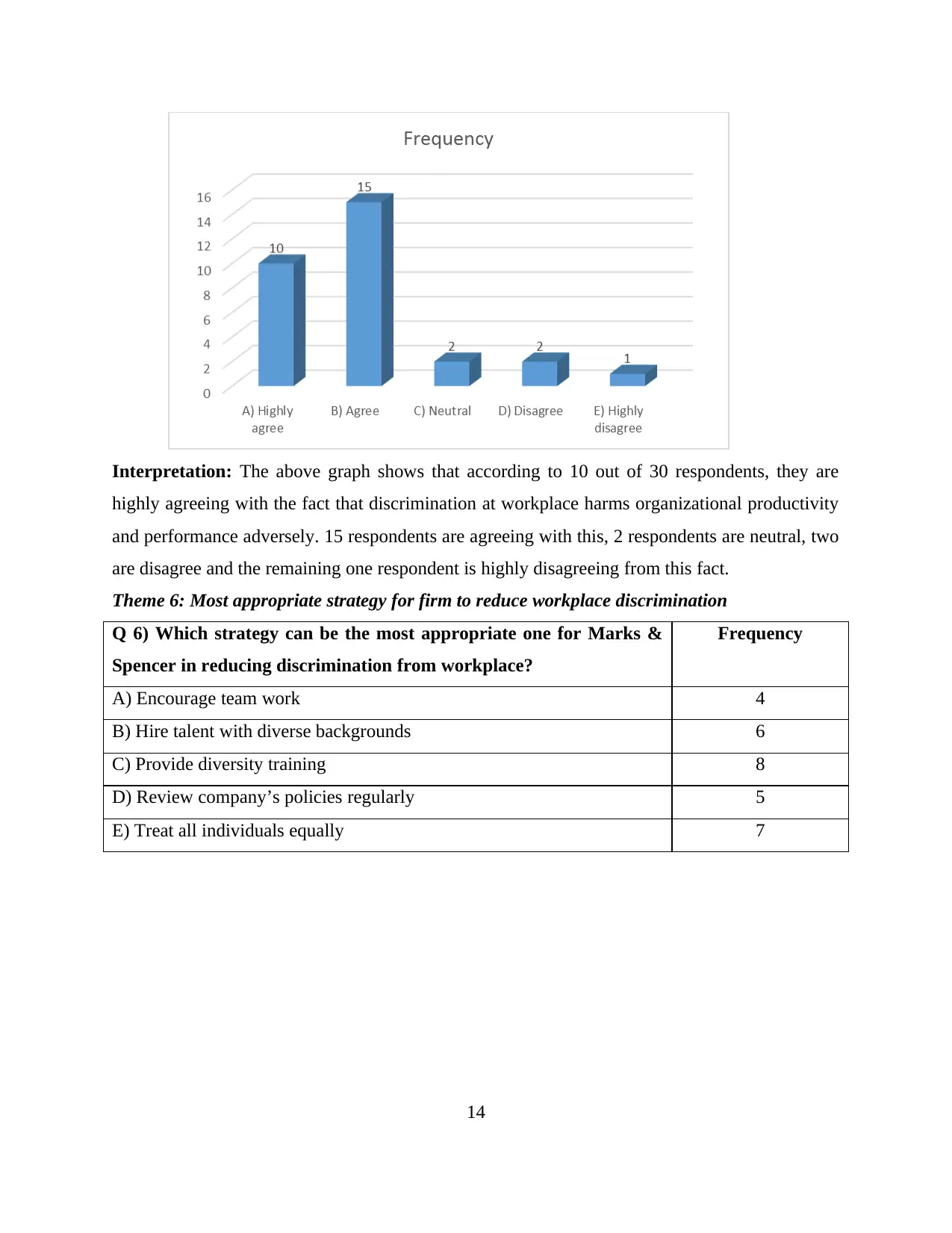
Interpretation: The above graph shows that according to 10 out of 30 respondents, they are
highly agreeing with the fact that discrimination at workplace harms organizational productivity
and performance adversely. 15 respondents are agreeing with this, 2 respondents are neutral, two
are disagree and the remaining one respondent is highly disagreeing from this fact.
Theme 6: Most appropriate strategy for firm to reduce workplace discrimination
Q 6) Which strategy can be the most appropriate one for Marks &
Spencer in reducing discrimination from workplace?
Frequency
A) Encourage team work 4
B) Hire talent with diverse backgrounds 6
C) Provide diversity training 8
D) Review company’s policies regularly 5
E) Treat all individuals equally 7
14
highly agreeing with the fact that discrimination at workplace harms organizational productivity
and performance adversely. 15 respondents are agreeing with this, 2 respondents are neutral, two
are disagree and the remaining one respondent is highly disagreeing from this fact.
Theme 6: Most appropriate strategy for firm to reduce workplace discrimination
Q 6) Which strategy can be the most appropriate one for Marks &
Spencer in reducing discrimination from workplace?
Frequency
A) Encourage team work 4
B) Hire talent with diverse backgrounds 6
C) Provide diversity training 8
D) Review company’s policies regularly 5
E) Treat all individuals equally 7
14
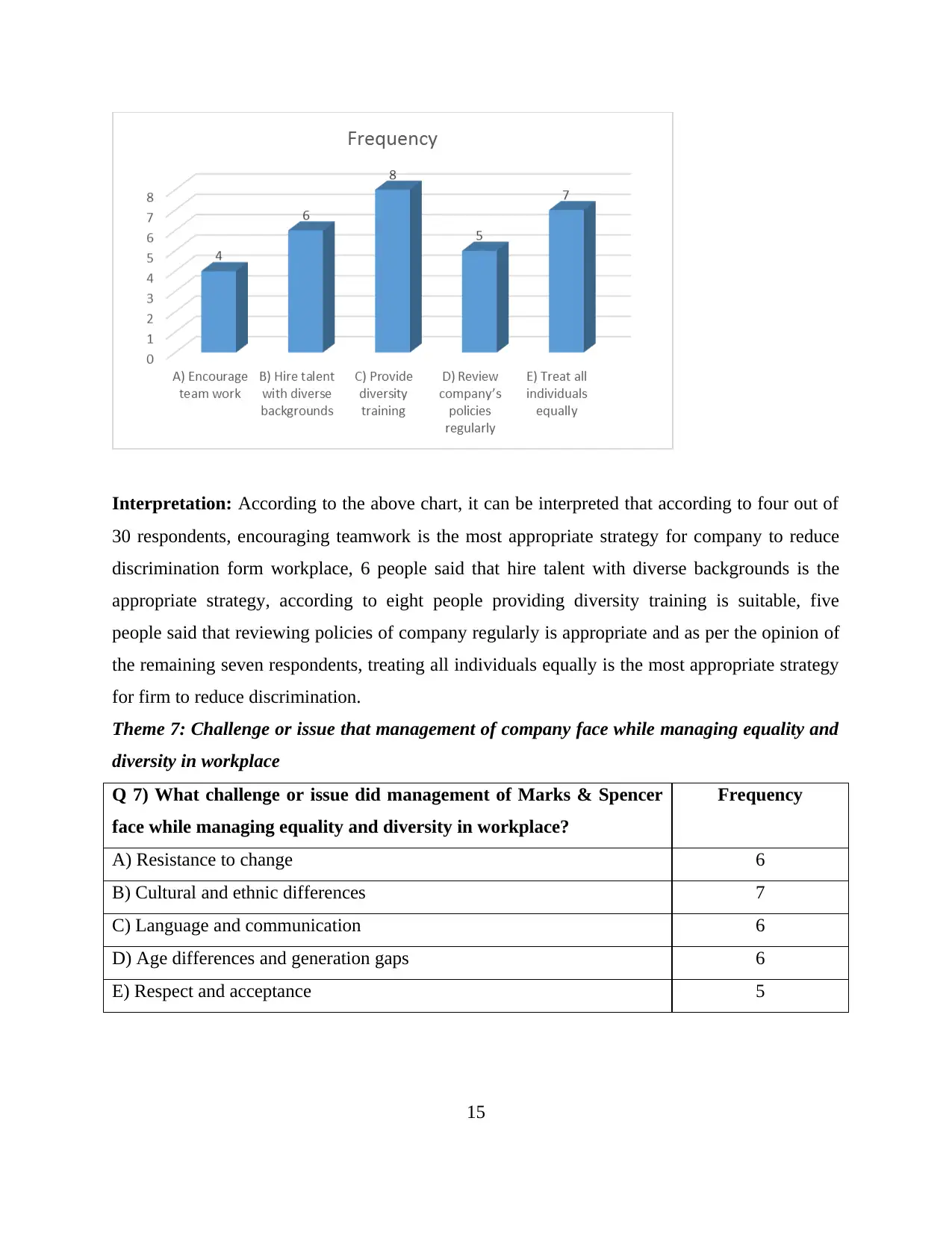
Interpretation: According to the above chart, it can be interpreted that according to four out of
30 respondents, encouraging teamwork is the most appropriate strategy for company to reduce
discrimination form workplace, 6 people said that hire talent with diverse backgrounds is the
appropriate strategy, according to eight people providing diversity training is suitable, five
people said that reviewing policies of company regularly is appropriate and as per the opinion of
the remaining seven respondents, treating all individuals equally is the most appropriate strategy
for firm to reduce discrimination.
Theme 7: Challenge or issue that management of company face while managing equality and
diversity in workplace
Q 7) What challenge or issue did management of Marks & Spencer
face while managing equality and diversity in workplace?
Frequency
A) Resistance to change 6
B) Cultural and ethnic differences 7
C) Language and communication 6
D) Age differences and generation gaps 6
E) Respect and acceptance 5
15
30 respondents, encouraging teamwork is the most appropriate strategy for company to reduce
discrimination form workplace, 6 people said that hire talent with diverse backgrounds is the
appropriate strategy, according to eight people providing diversity training is suitable, five
people said that reviewing policies of company regularly is appropriate and as per the opinion of
the remaining seven respondents, treating all individuals equally is the most appropriate strategy
for firm to reduce discrimination.
Theme 7: Challenge or issue that management of company face while managing equality and
diversity in workplace
Q 7) What challenge or issue did management of Marks & Spencer
face while managing equality and diversity in workplace?
Frequency
A) Resistance to change 6
B) Cultural and ethnic differences 7
C) Language and communication 6
D) Age differences and generation gaps 6
E) Respect and acceptance 5
15
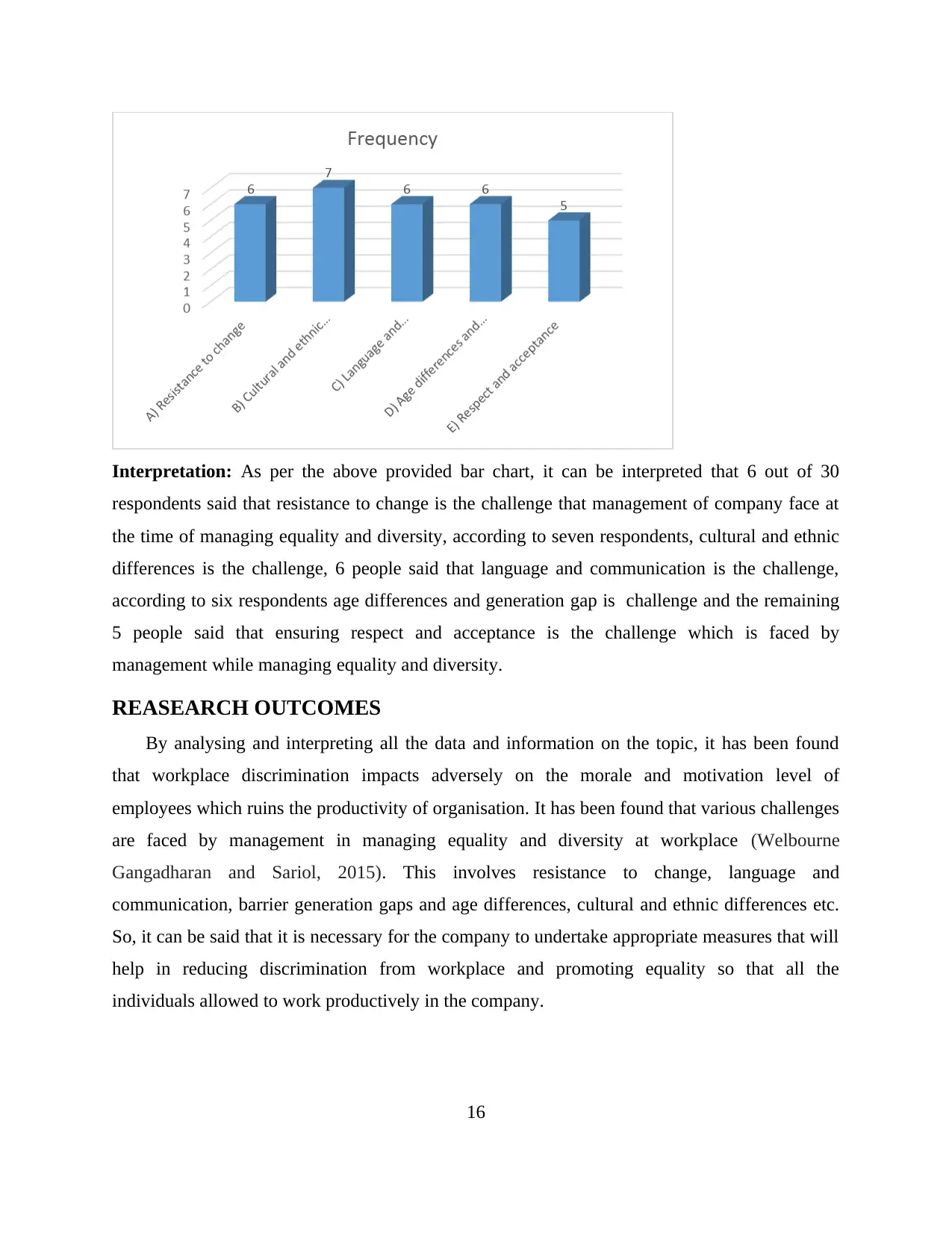
Interpretation: As per the above provided bar chart, it can be interpreted that 6 out of 30
respondents said that resistance to change is the challenge that management of company face at
the time of managing equality and diversity, according to seven respondents, cultural and ethnic
differences is the challenge, 6 people said that language and communication is the challenge,
according to six respondents age differences and generation gap is challenge and the remaining
5 people said that ensuring respect and acceptance is the challenge which is faced by
management while managing equality and diversity.
REASEARCH OUTCOMES
By analysing and interpreting all the data and information on the topic, it has been found
that workplace discrimination impacts adversely on the morale and motivation level of
employees which ruins the productivity of organisation. It has been found that various challenges
are faced by management in managing equality and diversity at workplace (Welbourne
Gangadharan and Sariol, 2015). This involves resistance to change, language and
communication, barrier generation gaps and age differences, cultural and ethnic differences etc.
So, it can be said that it is necessary for the company to undertake appropriate measures that will
help in reducing discrimination from workplace and promoting equality so that all the
individuals allowed to work productively in the company.
16
respondents said that resistance to change is the challenge that management of company face at
the time of managing equality and diversity, according to seven respondents, cultural and ethnic
differences is the challenge, 6 people said that language and communication is the challenge,
according to six respondents age differences and generation gap is challenge and the remaining
5 people said that ensuring respect and acceptance is the challenge which is faced by
management while managing equality and diversity.
REASEARCH OUTCOMES
By analysing and interpreting all the data and information on the topic, it has been found
that workplace discrimination impacts adversely on the morale and motivation level of
employees which ruins the productivity of organisation. It has been found that various challenges
are faced by management in managing equality and diversity at workplace (Welbourne
Gangadharan and Sariol, 2015). This involves resistance to change, language and
communication, barrier generation gaps and age differences, cultural and ethnic differences etc.
So, it can be said that it is necessary for the company to undertake appropriate measures that will
help in reducing discrimination from workplace and promoting equality so that all the
individuals allowed to work productively in the company.
16
Secure Best Marks with AI Grader
Need help grading? Try our AI Grader for instant feedback on your assignments.
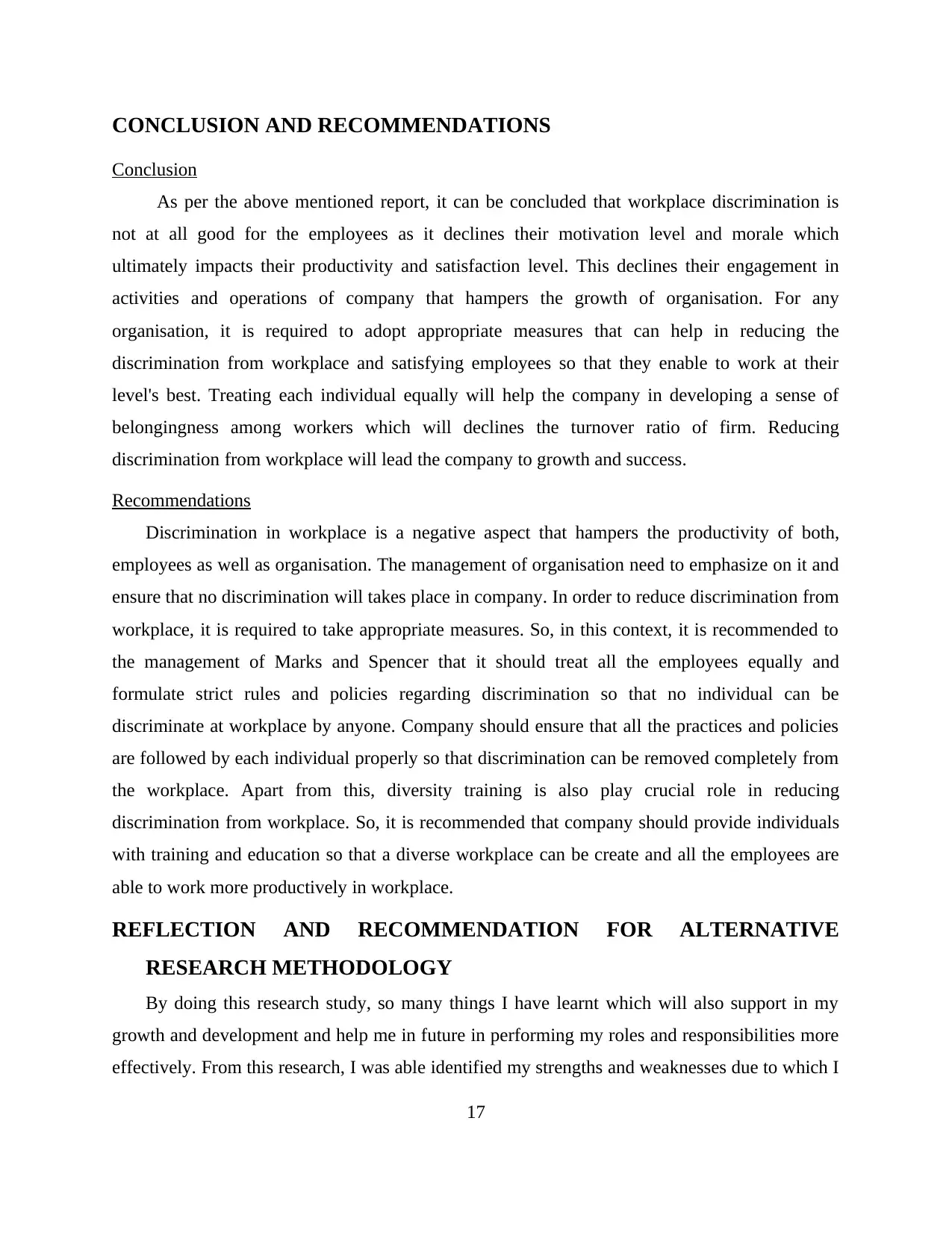
CONCLUSION AND RECOMMENDATIONS
Conclusion
As per the above mentioned report, it can be concluded that workplace discrimination is
not at all good for the employees as it declines their motivation level and morale which
ultimately impacts their productivity and satisfaction level. This declines their engagement in
activities and operations of company that hampers the growth of organisation. For any
organisation, it is required to adopt appropriate measures that can help in reducing the
discrimination from workplace and satisfying employees so that they enable to work at their
level's best. Treating each individual equally will help the company in developing a sense of
belongingness among workers which will declines the turnover ratio of firm. Reducing
discrimination from workplace will lead the company to growth and success.
Recommendations
Discrimination in workplace is a negative aspect that hampers the productivity of both,
employees as well as organisation. The management of organisation need to emphasize on it and
ensure that no discrimination will takes place in company. In order to reduce discrimination from
workplace, it is required to take appropriate measures. So, in this context, it is recommended to
the management of Marks and Spencer that it should treat all the employees equally and
formulate strict rules and policies regarding discrimination so that no individual can be
discriminate at workplace by anyone. Company should ensure that all the practices and policies
are followed by each individual properly so that discrimination can be removed completely from
the workplace. Apart from this, diversity training is also play crucial role in reducing
discrimination from workplace. So, it is recommended that company should provide individuals
with training and education so that a diverse workplace can be create and all the employees are
able to work more productively in workplace.
REFLECTION AND RECOMMENDATION FOR ALTERNATIVE
RESEARCH METHODOLOGY
By doing this research study, so many things I have learnt which will also support in my
growth and development and help me in future in performing my roles and responsibilities more
effectively. From this research, I was able identified my strengths and weaknesses due to which I
17
Conclusion
As per the above mentioned report, it can be concluded that workplace discrimination is
not at all good for the employees as it declines their motivation level and morale which
ultimately impacts their productivity and satisfaction level. This declines their engagement in
activities and operations of company that hampers the growth of organisation. For any
organisation, it is required to adopt appropriate measures that can help in reducing the
discrimination from workplace and satisfying employees so that they enable to work at their
level's best. Treating each individual equally will help the company in developing a sense of
belongingness among workers which will declines the turnover ratio of firm. Reducing
discrimination from workplace will lead the company to growth and success.
Recommendations
Discrimination in workplace is a negative aspect that hampers the productivity of both,
employees as well as organisation. The management of organisation need to emphasize on it and
ensure that no discrimination will takes place in company. In order to reduce discrimination from
workplace, it is required to take appropriate measures. So, in this context, it is recommended to
the management of Marks and Spencer that it should treat all the employees equally and
formulate strict rules and policies regarding discrimination so that no individual can be
discriminate at workplace by anyone. Company should ensure that all the practices and policies
are followed by each individual properly so that discrimination can be removed completely from
the workplace. Apart from this, diversity training is also play crucial role in reducing
discrimination from workplace. So, it is recommended that company should provide individuals
with training and education so that a diverse workplace can be create and all the employees are
able to work more productively in workplace.
REFLECTION AND RECOMMENDATION FOR ALTERNATIVE
RESEARCH METHODOLOGY
By doing this research study, so many things I have learnt which will also support in my
growth and development and help me in future in performing my roles and responsibilities more
effectively. From this research, I was able identified my strengths and weaknesses due to which I
17

am able to determine my development areas on which I need to work to improve them. In this
research, I worked in team which helped in improving my team working skills. However, during
working in team, I faced difficulties in interacting with others effectively. But, this research also
helped in improving my communication skills and now I am able to interact with others
appropriately. As the time is less for performing this research, some activities got delay. But with
the help of team members, I was able to complete the research on time. The overall experience of
performing this research is good. But, I realise that I should work more upon my communication
skills to make it much better. So for this, I will take help of online videos and sessions on
communication. By this, my communication skills will improve which help in my future career
development. In this research, I utilise quantitative method in order to ensure accuracy of data,
but I was able to collect less amount of data by using this method. But, in future if I perform
research I can also use qualitative method for gathering large amount of data. Apart from this,
instead of using inductive approach, I can use deductive approach too.
18
research, I worked in team which helped in improving my team working skills. However, during
working in team, I faced difficulties in interacting with others effectively. But, this research also
helped in improving my communication skills and now I am able to interact with others
appropriately. As the time is less for performing this research, some activities got delay. But with
the help of team members, I was able to complete the research on time. The overall experience of
performing this research is good. But, I realise that I should work more upon my communication
skills to make it much better. So for this, I will take help of online videos and sessions on
communication. By this, my communication skills will improve which help in my future career
development. In this research, I utilise quantitative method in order to ensure accuracy of data,
but I was able to collect less amount of data by using this method. But, in future if I perform
research I can also use qualitative method for gathering large amount of data. Apart from this,
instead of using inductive approach, I can use deductive approach too.
18
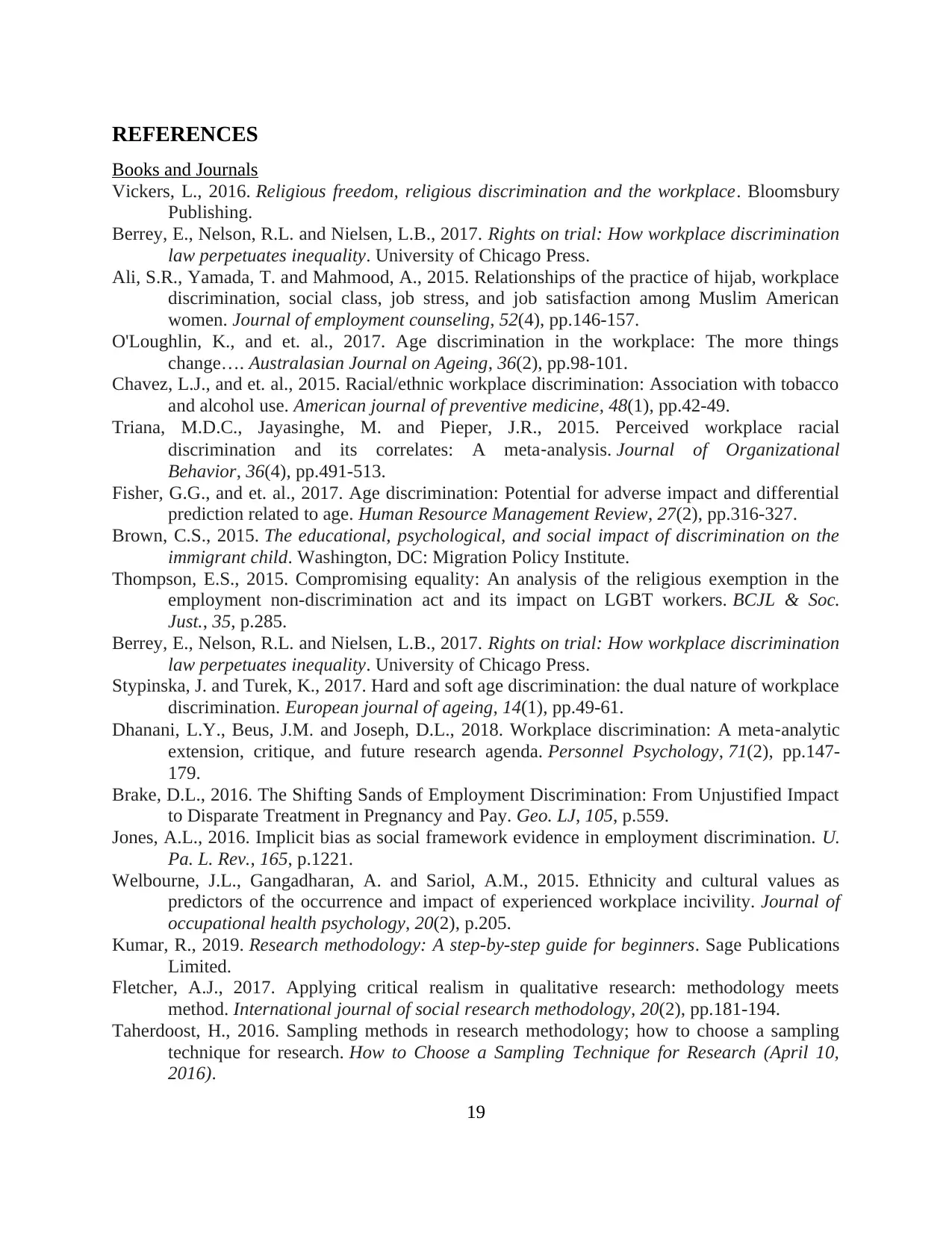
REFERENCES
Books and Journals
Vickers, L., 2016. Religious freedom, religious discrimination and the workplace. Bloomsbury
Publishing.
Berrey, E., Nelson, R.L. and Nielsen, L.B., 2017. Rights on trial: How workplace discrimination
law perpetuates inequality. University of Chicago Press.
Ali, S.R., Yamada, T. and Mahmood, A., 2015. Relationships of the practice of hijab, workplace
discrimination, social class, job stress, and job satisfaction among Muslim American
women. Journal of employment counseling, 52(4), pp.146-157.
O'Loughlin, K., and et. al., 2017. Age discrimination in the workplace: The more things
change…. Australasian Journal on Ageing, 36(2), pp.98-101.
Chavez, L.J., and et. al., 2015. Racial/ethnic workplace discrimination: Association with tobacco
and alcohol use. American journal of preventive medicine, 48(1), pp.42-49.
Triana, M.D.C., Jayasinghe, M. and Pieper, J.R., 2015. Perceived workplace racial
discrimination and its correlates: A meta‐analysis. Journal of Organizational
Behavior, 36(4), pp.491-513.
Fisher, G.G., and et. al., 2017. Age discrimination: Potential for adverse impact and differential
prediction related to age. Human Resource Management Review, 27(2), pp.316-327.
Brown, C.S., 2015. The educational, psychological, and social impact of discrimination on the
immigrant child. Washington, DC: Migration Policy Institute.
Thompson, E.S., 2015. Compromising equality: An analysis of the religious exemption in the
employment non-discrimination act and its impact on LGBT workers. BCJL & Soc.
Just., 35, p.285.
Berrey, E., Nelson, R.L. and Nielsen, L.B., 2017. Rights on trial: How workplace discrimination
law perpetuates inequality. University of Chicago Press.
Stypinska, J. and Turek, K., 2017. Hard and soft age discrimination: the dual nature of workplace
discrimination. European journal of ageing, 14(1), pp.49-61.
Dhanani, L.Y., Beus, J.M. and Joseph, D.L., 2018. Workplace discrimination: A meta‐analytic
extension, critique, and future research agenda. Personnel Psychology, 71(2), pp.147-
179.
Brake, D.L., 2016. The Shifting Sands of Employment Discrimination: From Unjustified Impact
to Disparate Treatment in Pregnancy and Pay. Geo. LJ, 105, p.559.
Jones, A.L., 2016. Implicit bias as social framework evidence in employment discrimination. U.
Pa. L. Rev., 165, p.1221.
Welbourne, J.L., Gangadharan, A. and Sariol, A.M., 2015. Ethnicity and cultural values as
predictors of the occurrence and impact of experienced workplace incivility. Journal of
occupational health psychology, 20(2), p.205.
Kumar, R., 2019. Research methodology: A step-by-step guide for beginners. Sage Publications
Limited.
Fletcher, A.J., 2017. Applying critical realism in qualitative research: methodology meets
method. International journal of social research methodology, 20(2), pp.181-194.
Taherdoost, H., 2016. Sampling methods in research methodology; how to choose a sampling
technique for research. How to Choose a Sampling Technique for Research (April 10,
2016).
19
Books and Journals
Vickers, L., 2016. Religious freedom, religious discrimination and the workplace. Bloomsbury
Publishing.
Berrey, E., Nelson, R.L. and Nielsen, L.B., 2017. Rights on trial: How workplace discrimination
law perpetuates inequality. University of Chicago Press.
Ali, S.R., Yamada, T. and Mahmood, A., 2015. Relationships of the practice of hijab, workplace
discrimination, social class, job stress, and job satisfaction among Muslim American
women. Journal of employment counseling, 52(4), pp.146-157.
O'Loughlin, K., and et. al., 2017. Age discrimination in the workplace: The more things
change…. Australasian Journal on Ageing, 36(2), pp.98-101.
Chavez, L.J., and et. al., 2015. Racial/ethnic workplace discrimination: Association with tobacco
and alcohol use. American journal of preventive medicine, 48(1), pp.42-49.
Triana, M.D.C., Jayasinghe, M. and Pieper, J.R., 2015. Perceived workplace racial
discrimination and its correlates: A meta‐analysis. Journal of Organizational
Behavior, 36(4), pp.491-513.
Fisher, G.G., and et. al., 2017. Age discrimination: Potential for adverse impact and differential
prediction related to age. Human Resource Management Review, 27(2), pp.316-327.
Brown, C.S., 2015. The educational, psychological, and social impact of discrimination on the
immigrant child. Washington, DC: Migration Policy Institute.
Thompson, E.S., 2015. Compromising equality: An analysis of the religious exemption in the
employment non-discrimination act and its impact on LGBT workers. BCJL & Soc.
Just., 35, p.285.
Berrey, E., Nelson, R.L. and Nielsen, L.B., 2017. Rights on trial: How workplace discrimination
law perpetuates inequality. University of Chicago Press.
Stypinska, J. and Turek, K., 2017. Hard and soft age discrimination: the dual nature of workplace
discrimination. European journal of ageing, 14(1), pp.49-61.
Dhanani, L.Y., Beus, J.M. and Joseph, D.L., 2018. Workplace discrimination: A meta‐analytic
extension, critique, and future research agenda. Personnel Psychology, 71(2), pp.147-
179.
Brake, D.L., 2016. The Shifting Sands of Employment Discrimination: From Unjustified Impact
to Disparate Treatment in Pregnancy and Pay. Geo. LJ, 105, p.559.
Jones, A.L., 2016. Implicit bias as social framework evidence in employment discrimination. U.
Pa. L. Rev., 165, p.1221.
Welbourne, J.L., Gangadharan, A. and Sariol, A.M., 2015. Ethnicity and cultural values as
predictors of the occurrence and impact of experienced workplace incivility. Journal of
occupational health psychology, 20(2), p.205.
Kumar, R., 2019. Research methodology: A step-by-step guide for beginners. Sage Publications
Limited.
Fletcher, A.J., 2017. Applying critical realism in qualitative research: methodology meets
method. International journal of social research methodology, 20(2), pp.181-194.
Taherdoost, H., 2016. Sampling methods in research methodology; how to choose a sampling
technique for research. How to Choose a Sampling Technique for Research (April 10,
2016).
19
Paraphrase This Document
Need a fresh take? Get an instant paraphrase of this document with our AI Paraphraser
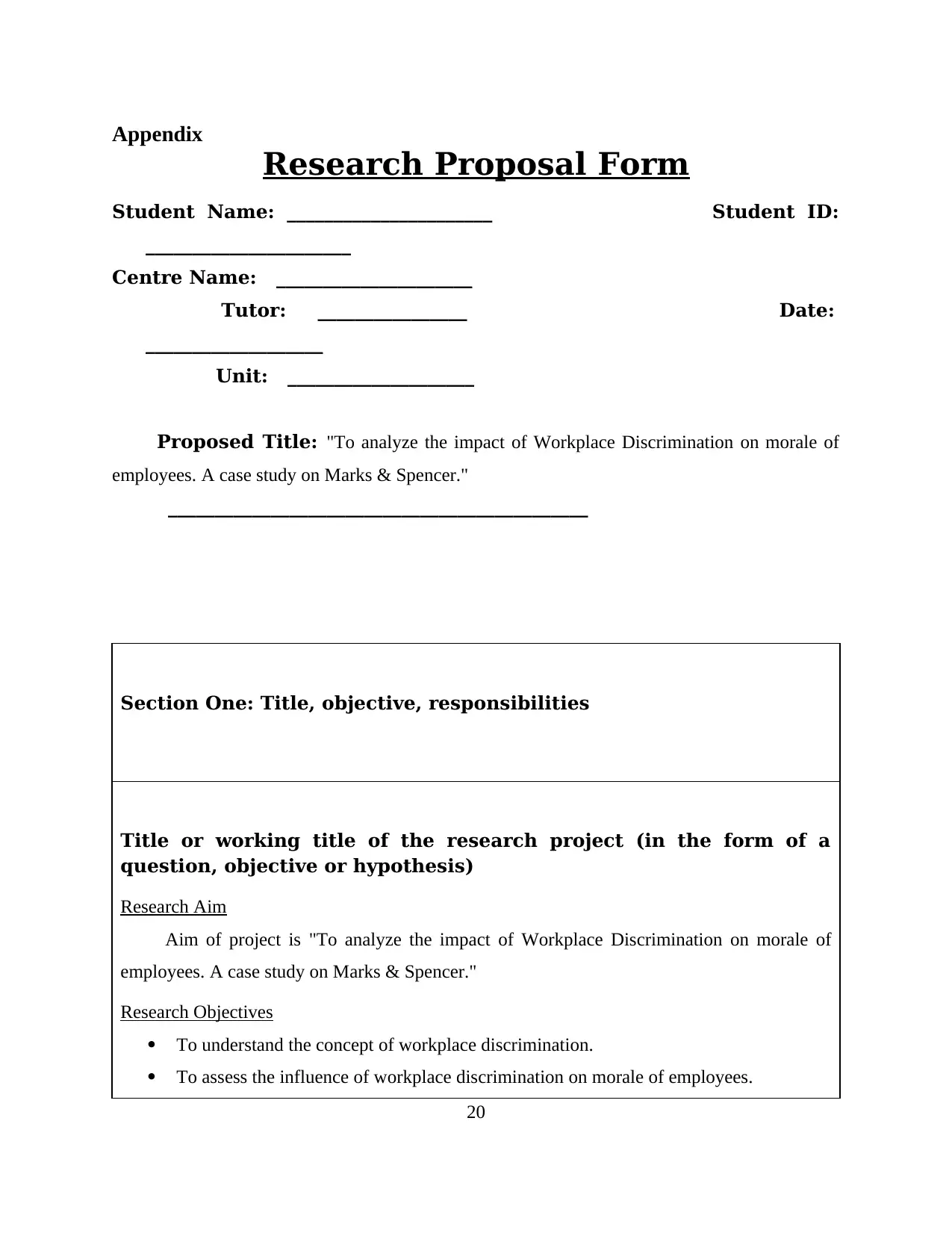
Appendix
Research Proposal Form
Student Name: ______________________ Student ID:
______________________
Centre Name: _____________________
Tutor: ________________ Date:
___________________
Unit: ____________________
Proposed Title: "To analyze the impact of Workplace Discrimination on morale of
employees. A case study on Marks & Spencer."
_____________________________________________
Section One: Title, objective, responsibilities
Title or working title of the research project (in the form of a
question, objective or hypothesis)
Research Aim
Aim of project is "To analyze the impact of Workplace Discrimination on morale of
employees. A case study on Marks & Spencer."
Research Objectives
To understand the concept of workplace discrimination.
To assess the influence of workplace discrimination on morale of employees.
20
Research Proposal Form
Student Name: ______________________ Student ID:
______________________
Centre Name: _____________________
Tutor: ________________ Date:
___________________
Unit: ____________________
Proposed Title: "To analyze the impact of Workplace Discrimination on morale of
employees. A case study on Marks & Spencer."
_____________________________________________
Section One: Title, objective, responsibilities
Title or working title of the research project (in the form of a
question, objective or hypothesis)
Research Aim
Aim of project is "To analyze the impact of Workplace Discrimination on morale of
employees. A case study on Marks & Spencer."
Research Objectives
To understand the concept of workplace discrimination.
To assess the influence of workplace discrimination on morale of employees.
20
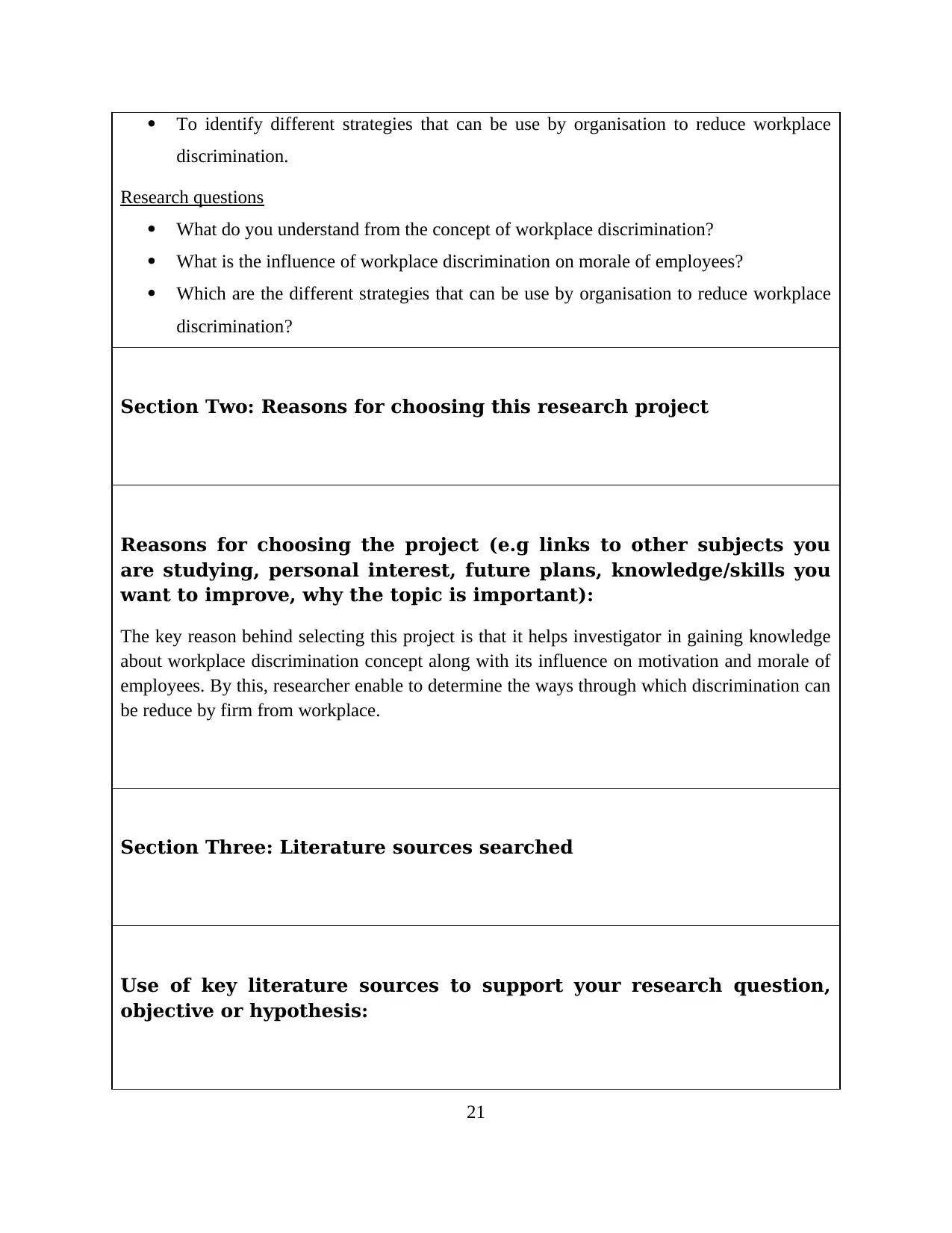
To identify different strategies that can be use by organisation to reduce workplace
discrimination.
Research questions
What do you understand from the concept of workplace discrimination?
What is the influence of workplace discrimination on morale of employees?
Which are the different strategies that can be use by organisation to reduce workplace
discrimination?
Section Two: Reasons for choosing this research project
Reasons for choosing the project (e.g links to other subjects you
are studying, personal interest, future plans, knowledge/skills you
want to improve, why the topic is important):
The key reason behind selecting this project is that it helps investigator in gaining knowledge
about workplace discrimination concept along with its influence on motivation and morale of
employees. By this, researcher enable to determine the ways through which discrimination can
be reduce by firm from workplace.
Section Three: Literature sources searched
Use of key literature sources to support your research question,
objective or hypothesis:
21
discrimination.
Research questions
What do you understand from the concept of workplace discrimination?
What is the influence of workplace discrimination on morale of employees?
Which are the different strategies that can be use by organisation to reduce workplace
discrimination?
Section Two: Reasons for choosing this research project
Reasons for choosing the project (e.g links to other subjects you
are studying, personal interest, future plans, knowledge/skills you
want to improve, why the topic is important):
The key reason behind selecting this project is that it helps investigator in gaining knowledge
about workplace discrimination concept along with its influence on motivation and morale of
employees. By this, researcher enable to determine the ways through which discrimination can
be reduce by firm from workplace.
Section Three: Literature sources searched
Use of key literature sources to support your research question,
objective or hypothesis:
21
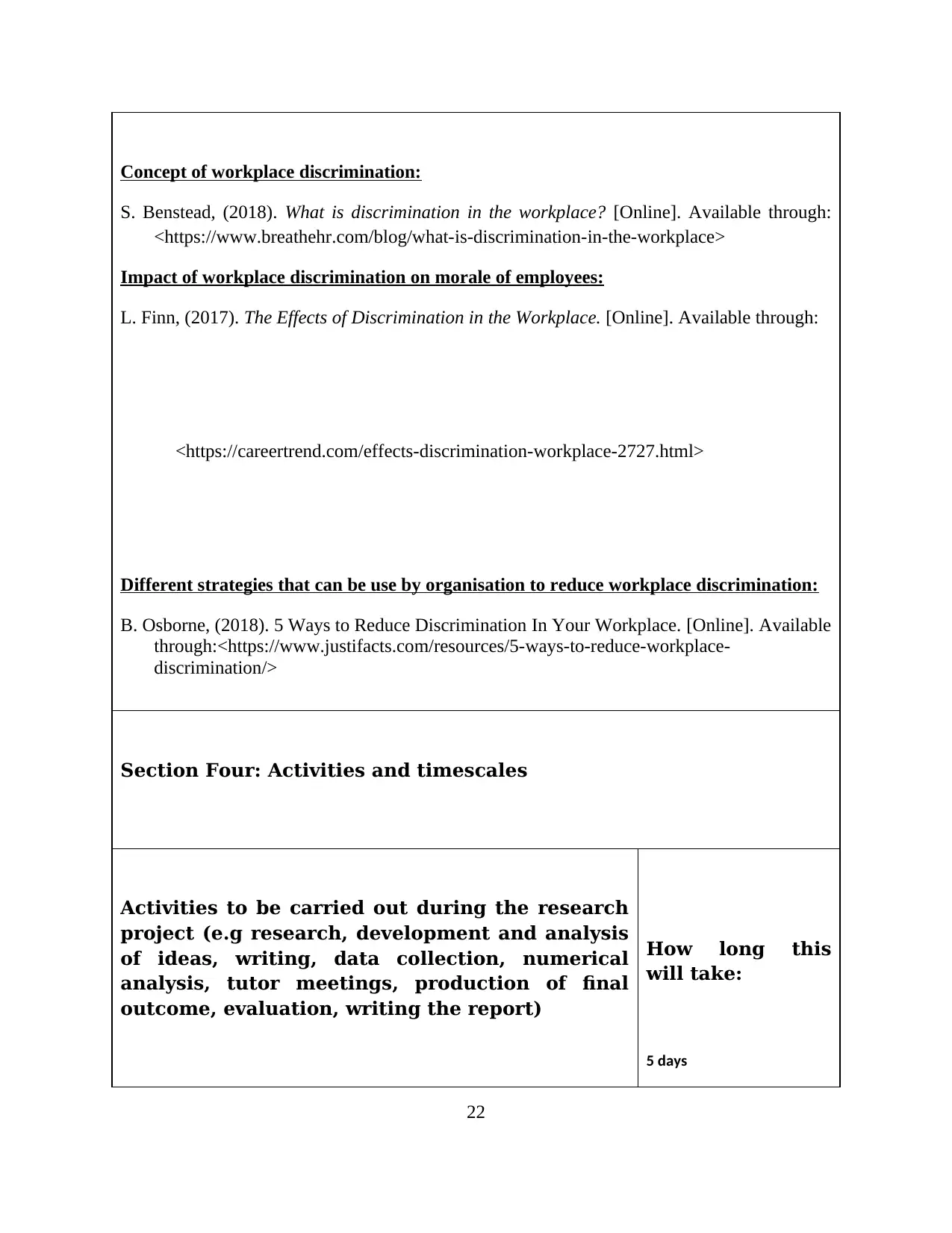
Concept of workplace discrimination:
S. Benstead, (2018). What is discrimination in the workplace? [Online]. Available through:
<https://www.breathehr.com/blog/what-is-discrimination-in-the-workplace>
Impact of workplace discrimination on morale of employees:
L. Finn, (2017). The Effects of Discrimination in the Workplace. [Online]. Available through:
<https://careertrend.com/effects-discrimination-workplace-2727.html>
Different strategies that can be use by organisation to reduce workplace discrimination:
B. Osborne, (2018). 5 Ways to Reduce Discrimination In Your Workplace. [Online]. Available
through:<https://www.justifacts.com/resources/5-ways-to-reduce-workplace-
discrimination/>
Section Four: Activities and timescales
Activities to be carried out during the research
project (e.g research, development and analysis
of ideas, writing, data collection, numerical
analysis, tutor meetings, production of final
outcome, evaluation, writing the report)
How long this
will take:
5 days
22
S. Benstead, (2018). What is discrimination in the workplace? [Online]. Available through:
<https://www.breathehr.com/blog/what-is-discrimination-in-the-workplace>
Impact of workplace discrimination on morale of employees:
L. Finn, (2017). The Effects of Discrimination in the Workplace. [Online]. Available through:
<https://careertrend.com/effects-discrimination-workplace-2727.html>
Different strategies that can be use by organisation to reduce workplace discrimination:
B. Osborne, (2018). 5 Ways to Reduce Discrimination In Your Workplace. [Online]. Available
through:<https://www.justifacts.com/resources/5-ways-to-reduce-workplace-
discrimination/>
Section Four: Activities and timescales
Activities to be carried out during the research
project (e.g research, development and analysis
of ideas, writing, data collection, numerical
analysis, tutor meetings, production of final
outcome, evaluation, writing the report)
How long this
will take:
5 days
22
Secure Best Marks with AI Grader
Need help grading? Try our AI Grader for instant feedback on your assignments.

Gannt chart
Aims and objective
Research methodology
Literature review
Data collection
Data analysis
Conclusion and recommendations
Final submission
11 days
4 days
13 days
6 days
19 days
25 days
23
Aims and objective
Research methodology
Literature review
Data collection
Data analysis
Conclusion and recommendations
Final submission
11 days
4 days
13 days
6 days
19 days
25 days
23
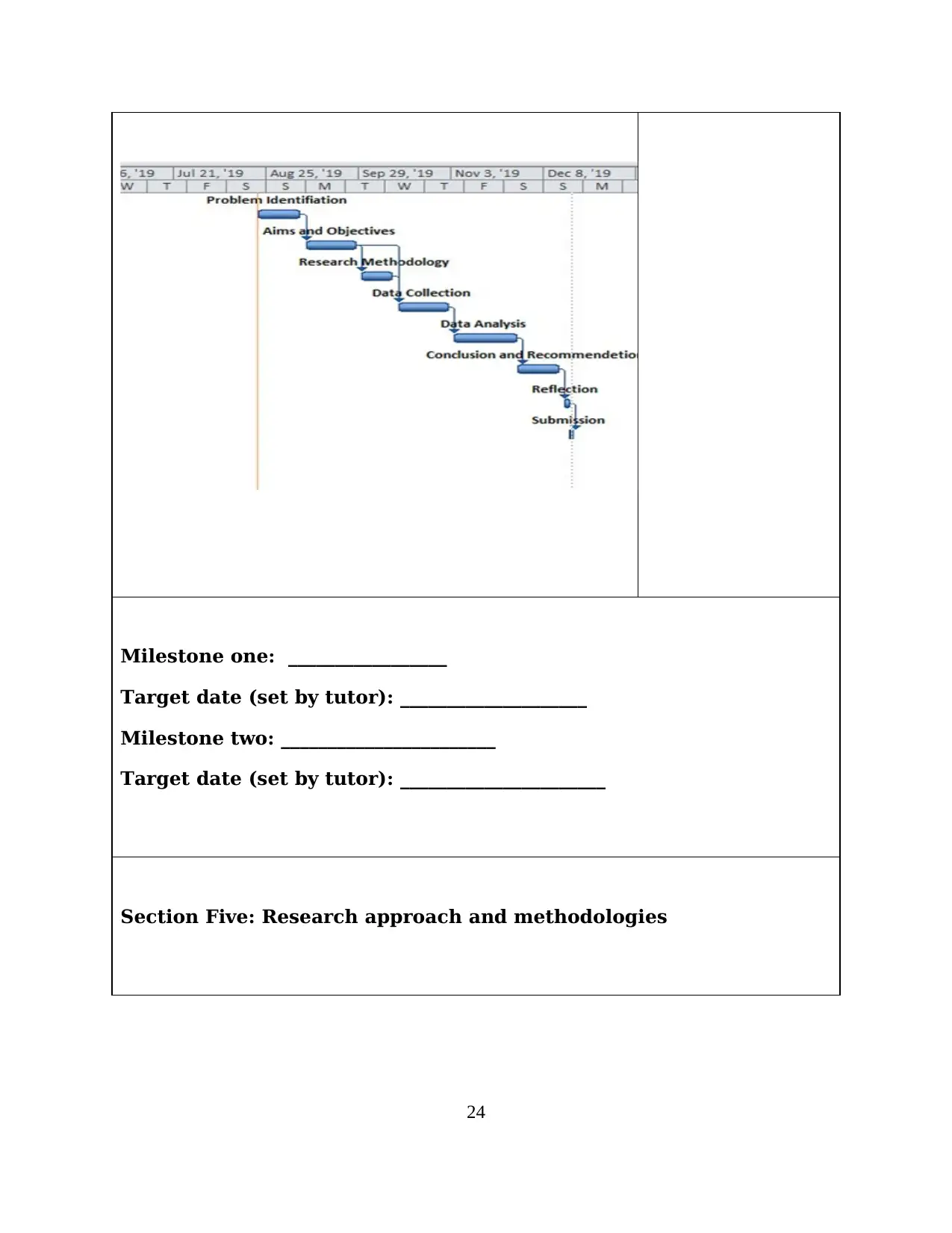
Milestone one: _________________
Target date (set by tutor): ____________________
Milestone two: _______________________
Target date (set by tutor): ______________________
Section Five: Research approach and methodologies
24
Target date (set by tutor): ____________________
Milestone two: _______________________
Target date (set by tutor): ______________________
Section Five: Research approach and methodologies
24
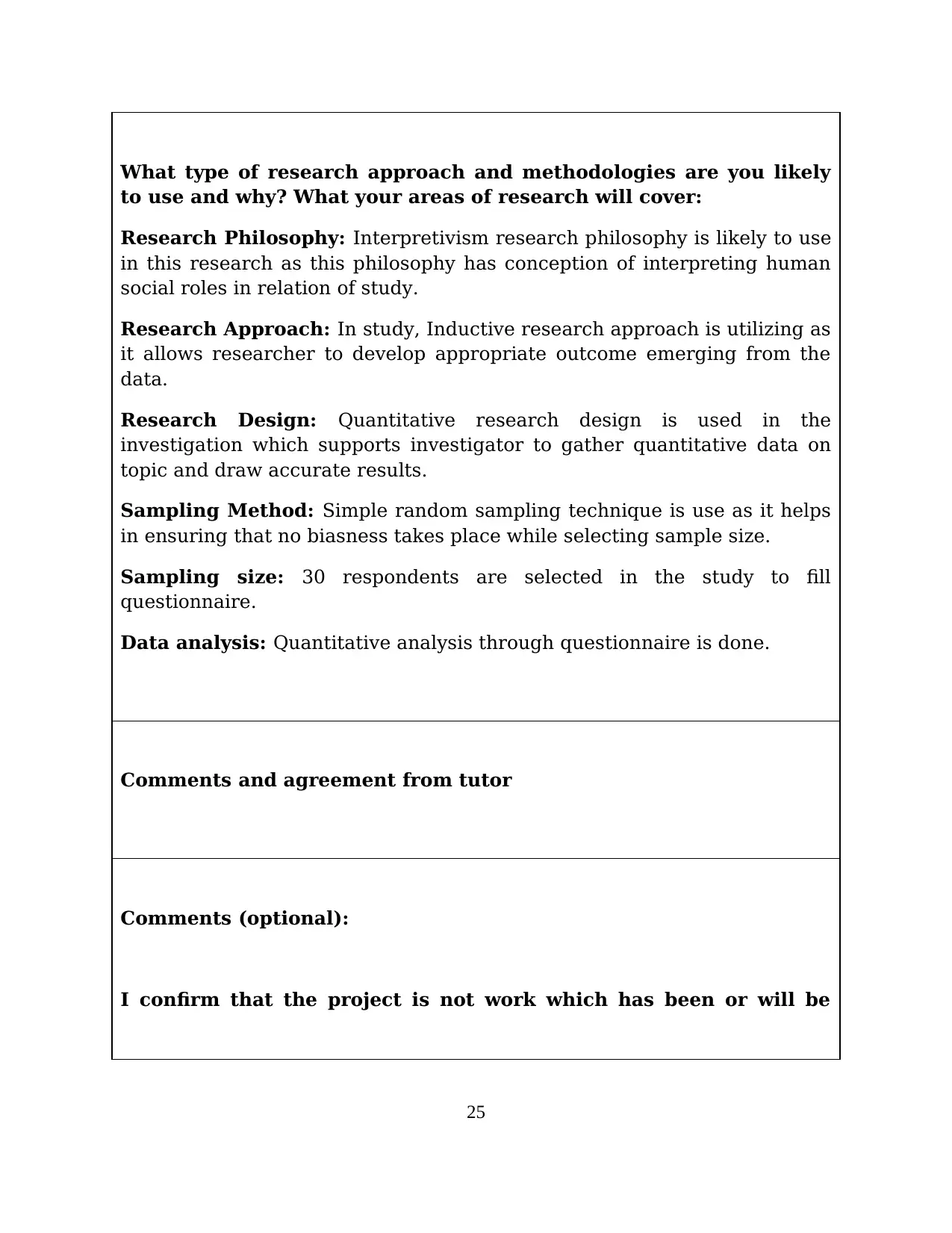
What type of research approach and methodologies are you likely
to use and why? What your areas of research will cover:
Research Philosophy: Interpretivism research philosophy is likely to use
in this research as this philosophy has conception of interpreting human
social roles in relation of study.
Research Approach: In study, Inductive research approach is utilizing as
it allows researcher to develop appropriate outcome emerging from the
data.
Research Design: Quantitative research design is used in the
investigation which supports investigator to gather quantitative data on
topic and draw accurate results.
Sampling Method: Simple random sampling technique is use as it helps
in ensuring that no biasness takes place while selecting sample size.
Sampling size: 30 respondents are selected in the study to fill
questionnaire.
Data analysis: Quantitative analysis through questionnaire is done.
Comments and agreement from tutor
Comments (optional):
I confirm that the project is not work which has been or will be
25
to use and why? What your areas of research will cover:
Research Philosophy: Interpretivism research philosophy is likely to use
in this research as this philosophy has conception of interpreting human
social roles in relation of study.
Research Approach: In study, Inductive research approach is utilizing as
it allows researcher to develop appropriate outcome emerging from the
data.
Research Design: Quantitative research design is used in the
investigation which supports investigator to gather quantitative data on
topic and draw accurate results.
Sampling Method: Simple random sampling technique is use as it helps
in ensuring that no biasness takes place while selecting sample size.
Sampling size: 30 respondents are selected in the study to fill
questionnaire.
Data analysis: Quantitative analysis through questionnaire is done.
Comments and agreement from tutor
Comments (optional):
I confirm that the project is not work which has been or will be
25
Paraphrase This Document
Need a fresh take? Get an instant paraphrase of this document with our AI Paraphraser
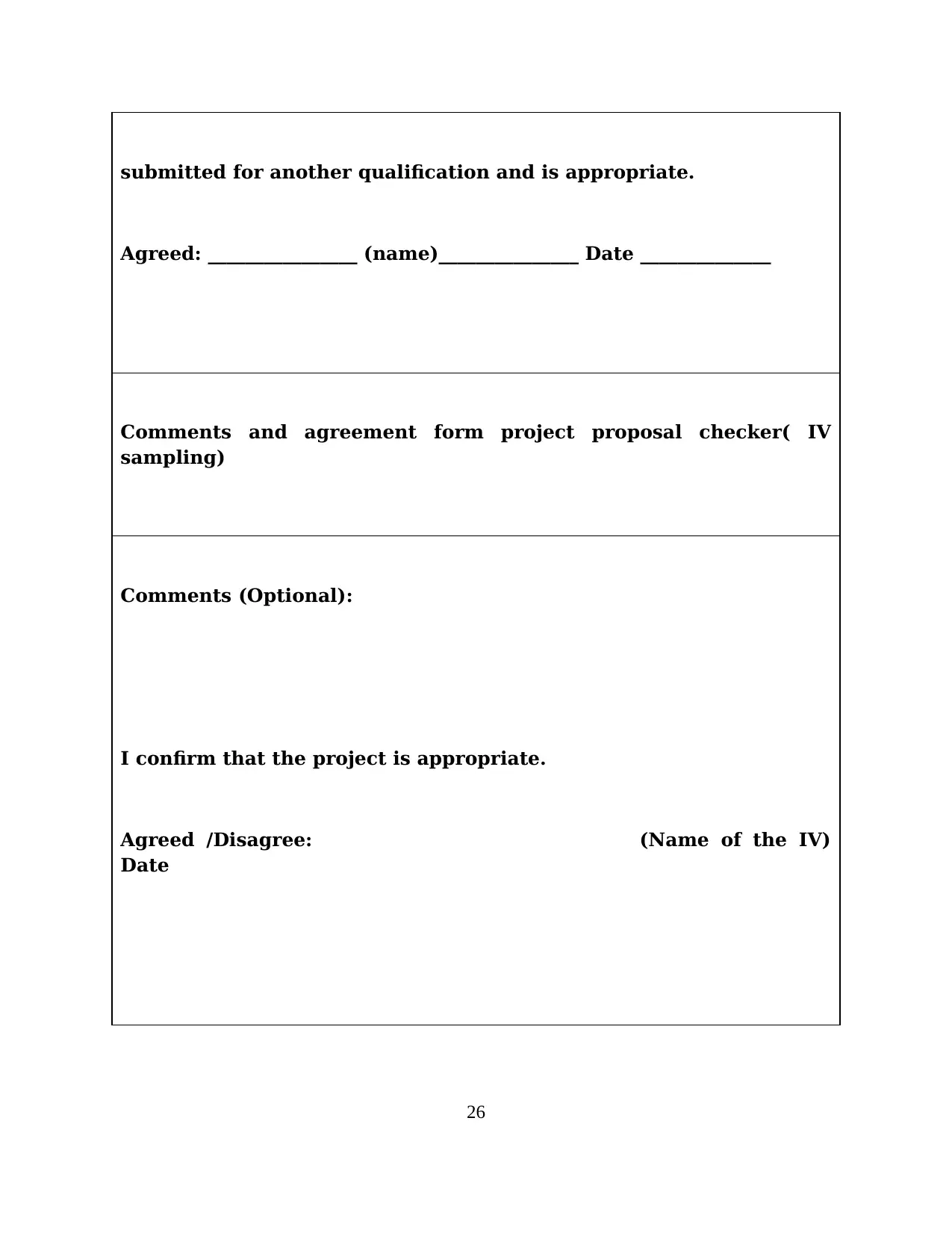
submitted for another qualification and is appropriate.
Agreed: ________________ (name)_______________ Date ______________
Comments and agreement form project proposal checker( IV
sampling)
Comments (Optional):
I confirm that the project is appropriate.
Agreed /Disagree: (Name of the IV)
Date
26
Agreed: ________________ (name)_______________ Date ______________
Comments and agreement form project proposal checker( IV
sampling)
Comments (Optional):
I confirm that the project is appropriate.
Agreed /Disagree: (Name of the IV)
Date
26

Research Ethics approval form
All students conducting research activity that involves human participants
or the use of data collected form human participants are required to gain
ethical approval before commencing their research. Please answer all
relevant questions and note that your form may be returned if incomplete.
For further support and guidance please see your respective Unit Tutor:
Before completing this form, we advise that you discuss your proposed research fully with your
unit tutor. Please complete this form in good time before your research project is due to
commence.
Section 1: Basic details:
Project title: "To analyze the impact of Workplace Discrimination on morale of
employees. A case study on Marks & Spencer."
Student name:
Student ID number:
Programme:
College Name:
Intended research start date:
Intended research end date:
27
All students conducting research activity that involves human participants
or the use of data collected form human participants are required to gain
ethical approval before commencing their research. Please answer all
relevant questions and note that your form may be returned if incomplete.
For further support and guidance please see your respective Unit Tutor:
Before completing this form, we advise that you discuss your proposed research fully with your
unit tutor. Please complete this form in good time before your research project is due to
commence.
Section 1: Basic details:
Project title: "To analyze the impact of Workplace Discrimination on morale of
employees. A case study on Marks & Spencer."
Student name:
Student ID number:
Programme:
College Name:
Intended research start date:
Intended research end date:
27
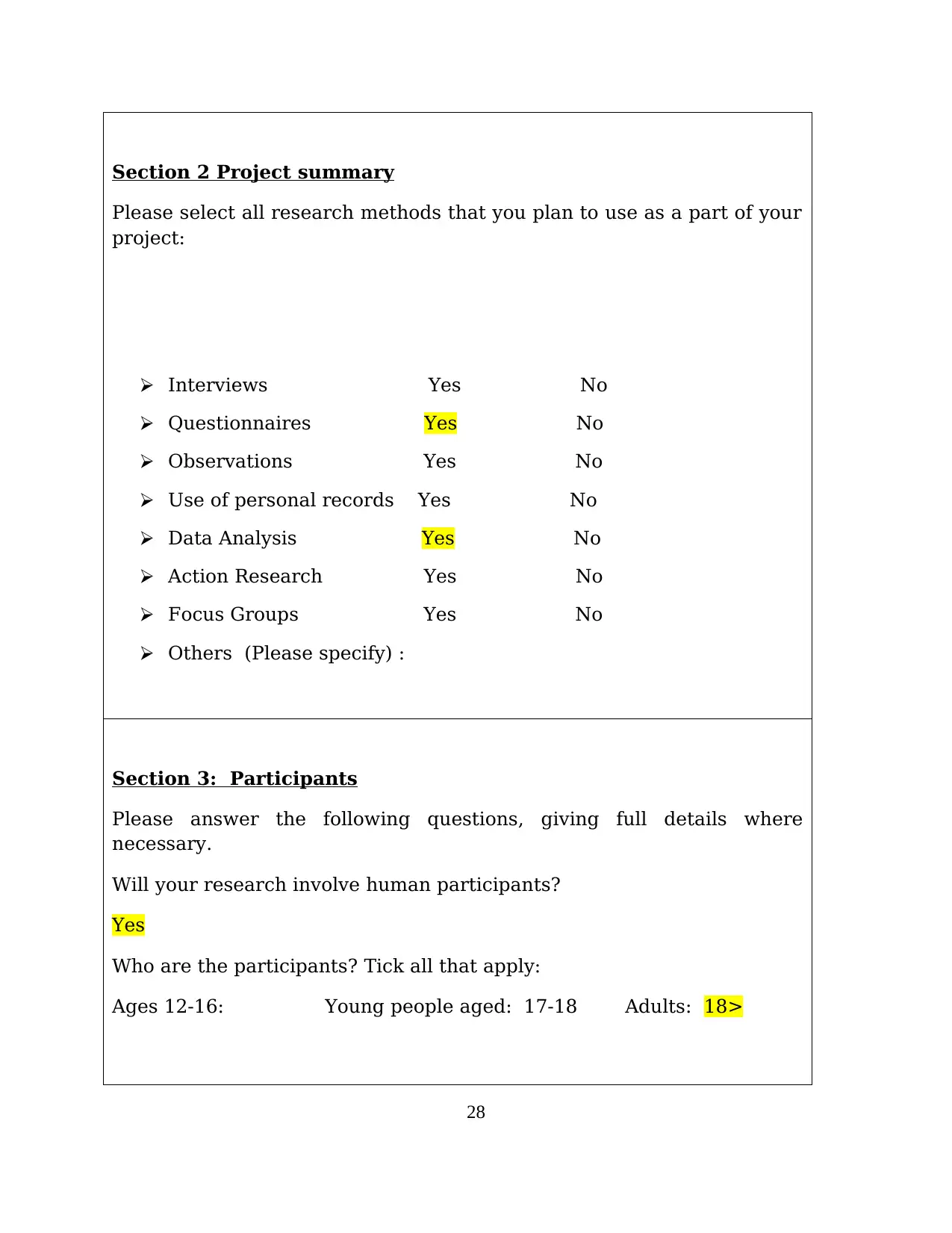
Section 2 Project summary
Please select all research methods that you plan to use as a part of your
project:
⮚ Interviews Yes No
⮚ Questionnaires Yes No
⮚ Observations Yes No
⮚ Use of personal records Yes No
⮚ Data Analysis Yes No
⮚ Action Research Yes No
⮚ Focus Groups Yes No
⮚ Others (Please specify) :
Section 3: Participants
Please answer the following questions, giving full details where
necessary.
Will your research involve human participants?
Yes
Who are the participants? Tick all that apply:
Ages 12-16: Young people aged: 17-18 Adults: 18>
28
Please select all research methods that you plan to use as a part of your
project:
⮚ Interviews Yes No
⮚ Questionnaires Yes No
⮚ Observations Yes No
⮚ Use of personal records Yes No
⮚ Data Analysis Yes No
⮚ Action Research Yes No
⮚ Focus Groups Yes No
⮚ Others (Please specify) :
Section 3: Participants
Please answer the following questions, giving full details where
necessary.
Will your research involve human participants?
Yes
Who are the participants? Tick all that apply:
Ages 12-16: Young people aged: 17-18 Adults: 18>
28
Secure Best Marks with AI Grader
Need help grading? Try our AI Grader for instant feedback on your assignments.
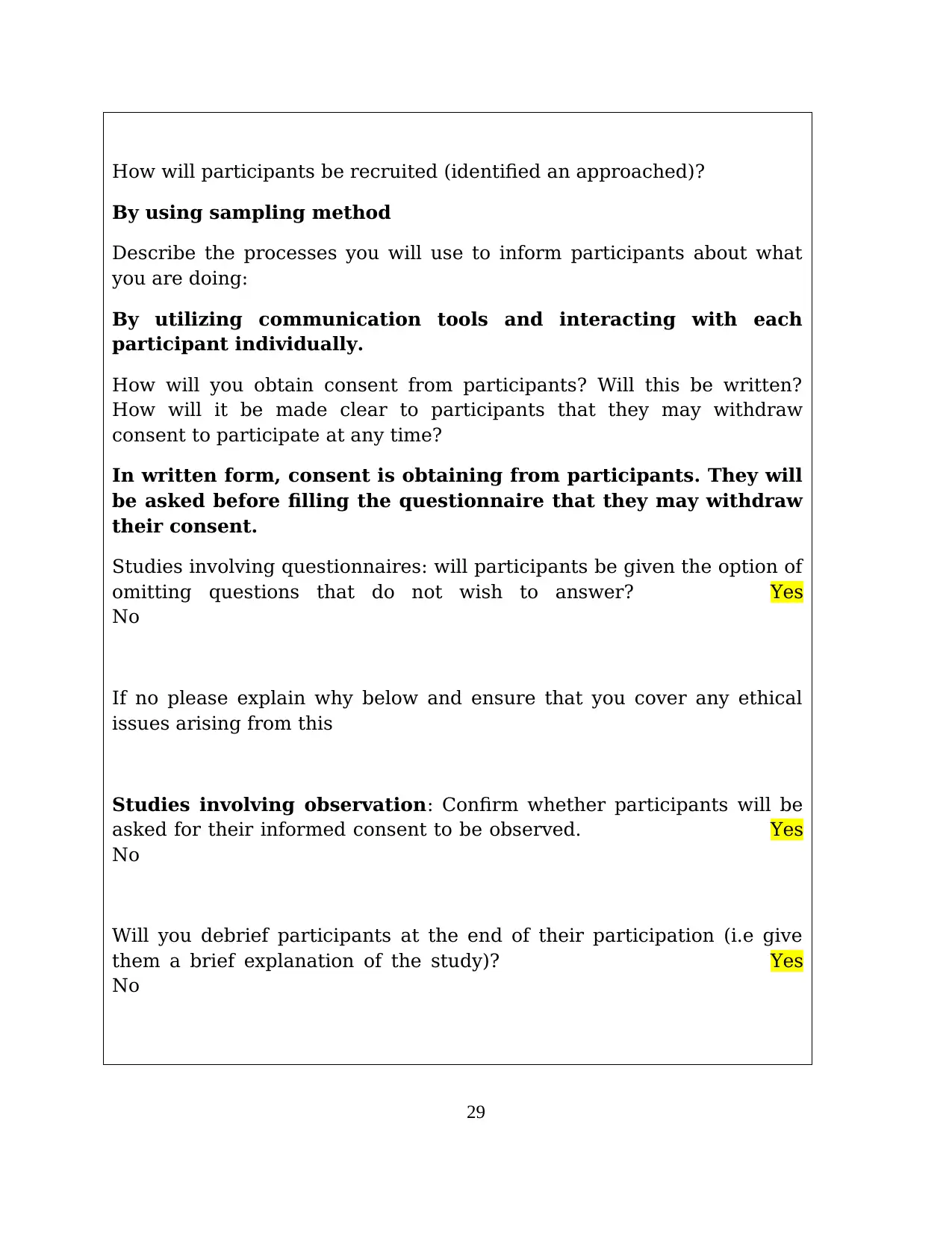
How will participants be recruited (identified an approached)?
By using sampling method
Describe the processes you will use to inform participants about what
you are doing:
By utilizing communication tools and interacting with each
participant individually.
How will you obtain consent from participants? Will this be written?
How will it be made clear to participants that they may withdraw
consent to participate at any time?
In written form, consent is obtaining from participants. They will
be asked before filling the questionnaire that they may withdraw
their consent.
Studies involving questionnaires: will participants be given the option of
omitting questions that do not wish to answer? Yes
No
If no please explain why below and ensure that you cover any ethical
issues arising from this
Studies involving observation: Confirm whether participants will be
asked for their informed consent to be observed. Yes
No
Will you debrief participants at the end of their participation (i.e give
them a brief explanation of the study)? Yes
No
29
By using sampling method
Describe the processes you will use to inform participants about what
you are doing:
By utilizing communication tools and interacting with each
participant individually.
How will you obtain consent from participants? Will this be written?
How will it be made clear to participants that they may withdraw
consent to participate at any time?
In written form, consent is obtaining from participants. They will
be asked before filling the questionnaire that they may withdraw
their consent.
Studies involving questionnaires: will participants be given the option of
omitting questions that do not wish to answer? Yes
No
If no please explain why below and ensure that you cover any ethical
issues arising from this
Studies involving observation: Confirm whether participants will be
asked for their informed consent to be observed. Yes
No
Will you debrief participants at the end of their participation (i.e give
them a brief explanation of the study)? Yes
No
29
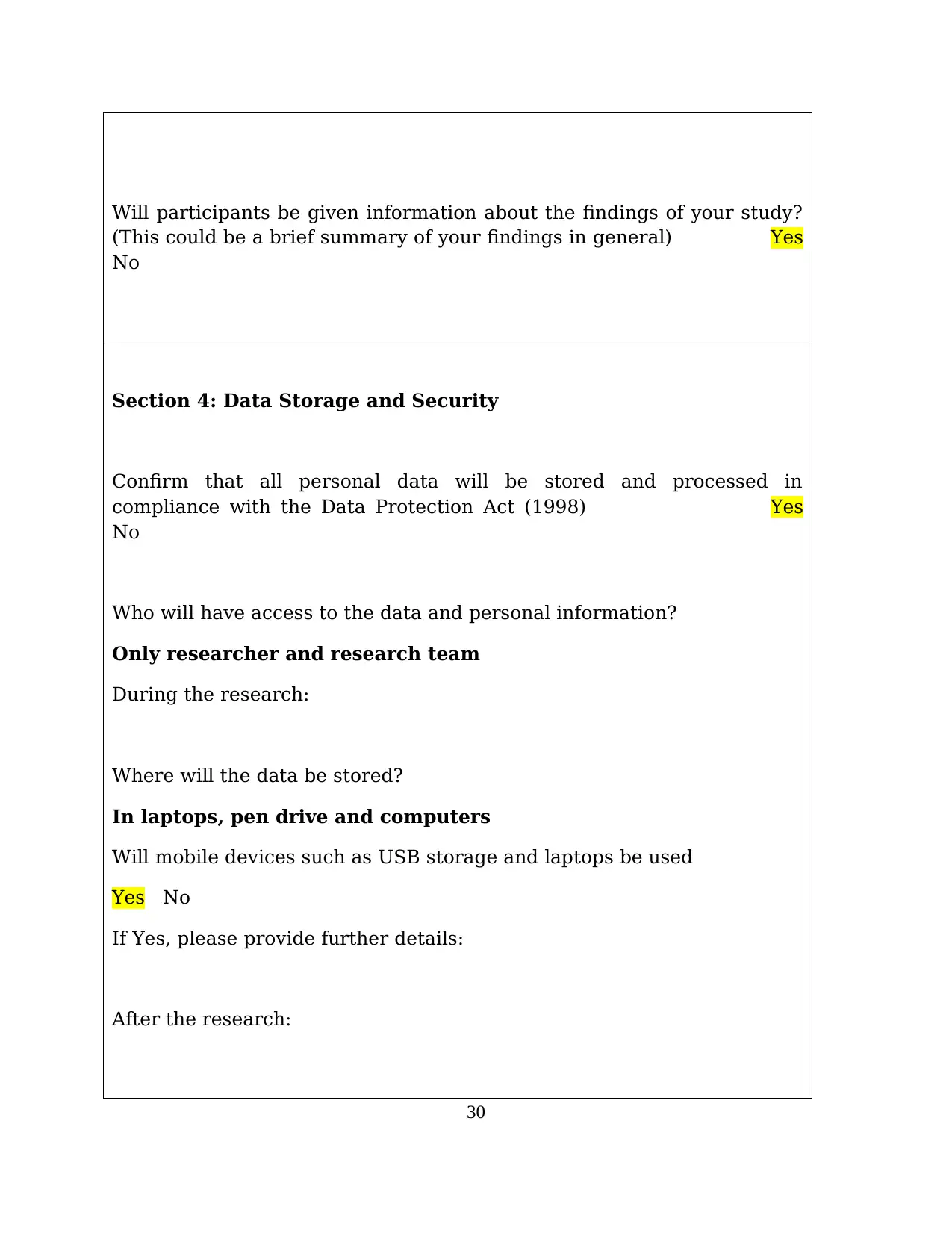
Will participants be given information about the findings of your study?
(This could be a brief summary of your findings in general) Yes
No
Section 4: Data Storage and Security
Confirm that all personal data will be stored and processed in
compliance with the Data Protection Act (1998) Yes
No
Who will have access to the data and personal information?
Only researcher and research team
During the research:
Where will the data be stored?
In laptops, pen drive and computers
Will mobile devices such as USB storage and laptops be used
Yes No
If Yes, please provide further details:
After the research:
30
(This could be a brief summary of your findings in general) Yes
No
Section 4: Data Storage and Security
Confirm that all personal data will be stored and processed in
compliance with the Data Protection Act (1998) Yes
No
Who will have access to the data and personal information?
Only researcher and research team
During the research:
Where will the data be stored?
In laptops, pen drive and computers
Will mobile devices such as USB storage and laptops be used
Yes No
If Yes, please provide further details:
After the research:
30

Where will the data be stored?
In laptops, computers and pan drive
How long will the data and records be kept for and in what format?
For 10 years
Will data be kept for use by other researchers? Yes No
Section 5 : Ethical Issues
Are there any particular features of your proposed work, which may
raise ethical concerns? If so, please outline how you will deal with these:
It is important that you demonstrate your awareness of potential risks
that may arise because of your research. Please consider/address all
issues that may apply. Ethical concerns may include, but are not limited
to the following :
⮚ Informed consent.
⮚ Potentially vulnerable participants.
⮚ Sensitive topics
⮚ Risk to participants and /or researchers
⮚ Confidentiality/anonymity
⮚ Disclosures/ limits to confidentiality
31
In laptops, computers and pan drive
How long will the data and records be kept for and in what format?
For 10 years
Will data be kept for use by other researchers? Yes No
Section 5 : Ethical Issues
Are there any particular features of your proposed work, which may
raise ethical concerns? If so, please outline how you will deal with these:
It is important that you demonstrate your awareness of potential risks
that may arise because of your research. Please consider/address all
issues that may apply. Ethical concerns may include, but are not limited
to the following :
⮚ Informed consent.
⮚ Potentially vulnerable participants.
⮚ Sensitive topics
⮚ Risk to participants and /or researchers
⮚ Confidentiality/anonymity
⮚ Disclosures/ limits to confidentiality
31
1 out of 31
Related Documents
Your All-in-One AI-Powered Toolkit for Academic Success.
+13062052269
info@desklib.com
Available 24*7 on WhatsApp / Email
![[object Object]](/_next/static/media/star-bottom.7253800d.svg)
Unlock your academic potential
© 2024 | Zucol Services PVT LTD | All rights reserved.





